The Australian A-League is quickly becoming one of the most proficient leagues in terms of youth development. During the 2022/23 season and the current transfer window, leading into the 2023/24 campaign, we have seen quite a few players make the move from Australia to Europe. Garang Kuol swapped Central Coast Mariners for Premier League side Newcastle United back in January 2023, and more recently, Celtic have signed winger Marco Tilio from Melbourne City whilst his teammate Jordan Bos is Belgium-bound, having agreed to a deal with KVC Westerlo.
In this A League data analysis, we will look into the young players (aged 23 and under) who were given first-team opportunities in the A-League throughout last season, including those mentioned above. We will use data and statistics to analyse their performances and see if we can highlight any more potential gems who could move to Europe soon.
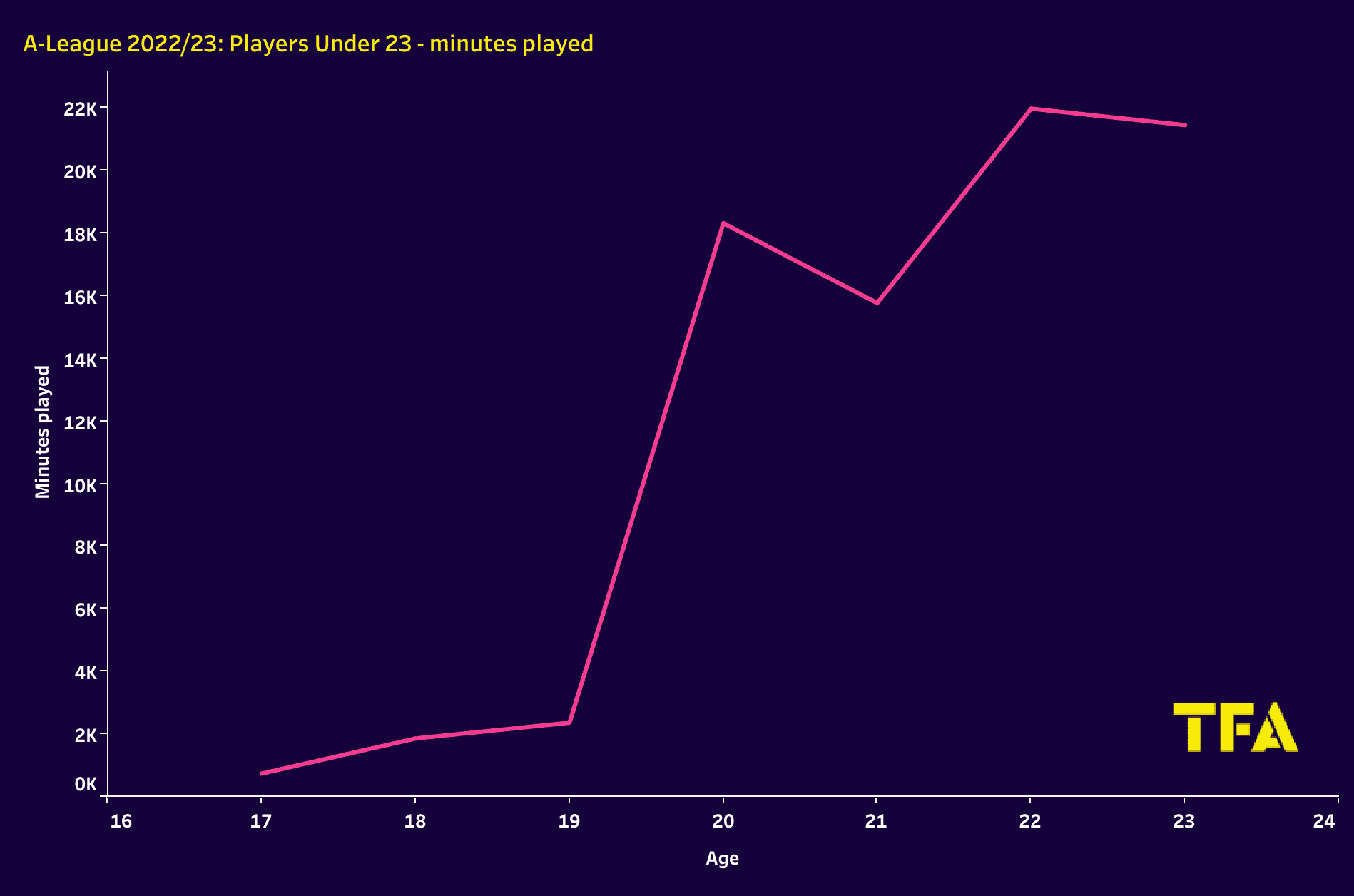
To begin this analysis, we can see from the data visual above that players under the age of 23 have received a vast amount of playing time throughout the season. A-League clubs benefit from giving young players first-team opportunities because it allows them to develop their skills and gain valuable experience at a professional level, increasing their transfer value. By providing these opportunities, the club can nurture and shape the talents of young players, helping them reach their full potential.
Furthermore, incorporating young players into the first team can save the club significant amounts of money that would otherwise be spent on buying established players in the transfer market. Additionally, Australian football clubs have invested in their youth development setups, for example, Melbourne City has enjoyed the financial advantages of being owned by City Football Group, and this is now paying dividends as the youth system is producing quality young players that not only boost the level of the league as a whole but also mean that Melbourne City will be able to recoup significant transfer fees for said players.
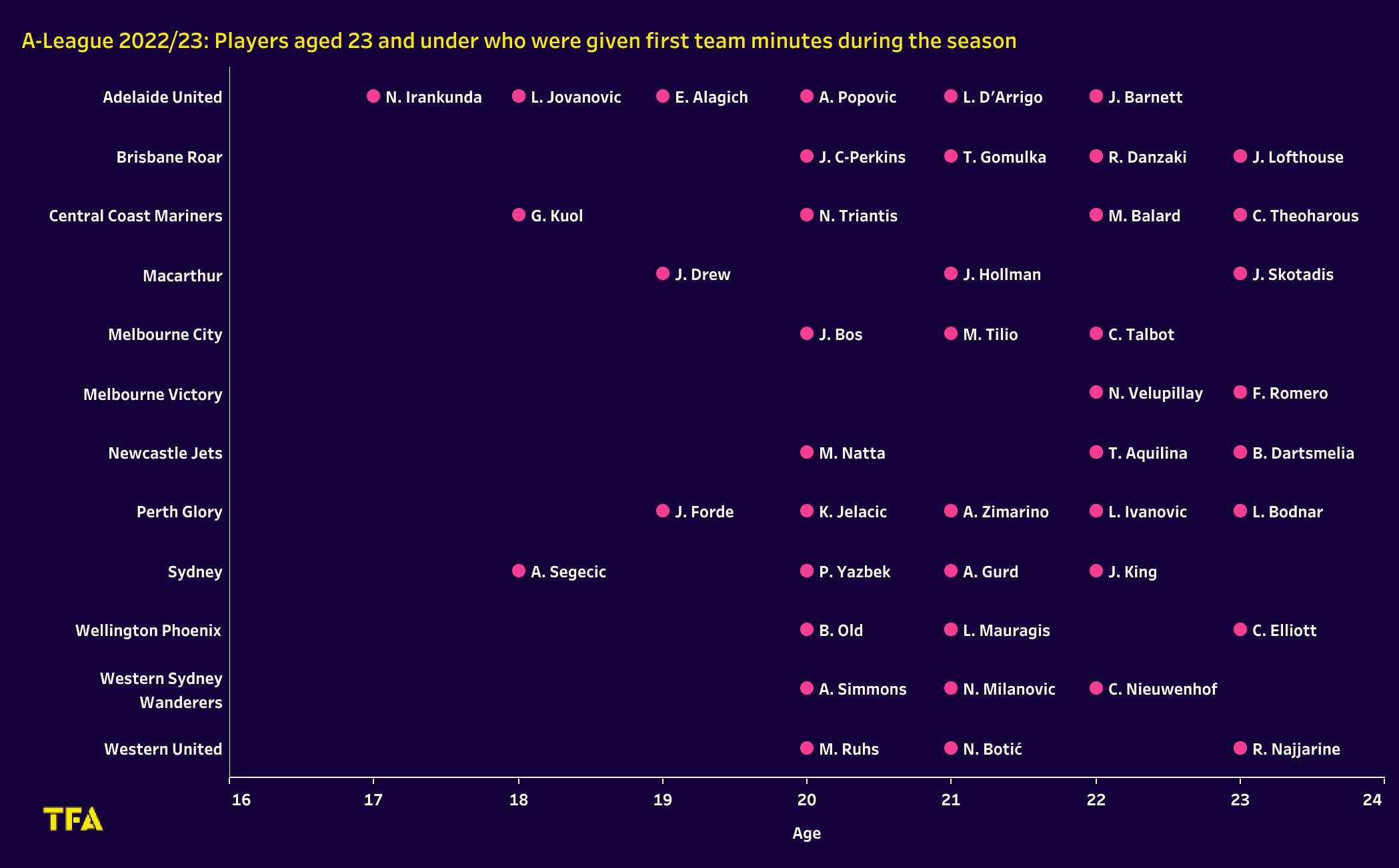
In the data visual above, we can observe the number of players under the age of 23 who were given playing time by each team throughout the season. Adelaide United stands out as they provided game time to five U23 players, with particular attention given to Nestory Irankunda, a talented 17-year-old player who we will look at in more detail later in this analysis. On the other hand, Melbourne City fielded three U23 players, but unfortunately, two of them have already departed from the club. It will be intriguing to see which young talents they choose to promote to the first team in preparation for the upcoming 2023/24 campaign.
Please note: the sample consists of players who played over 500 minutes this season.
Full-backs
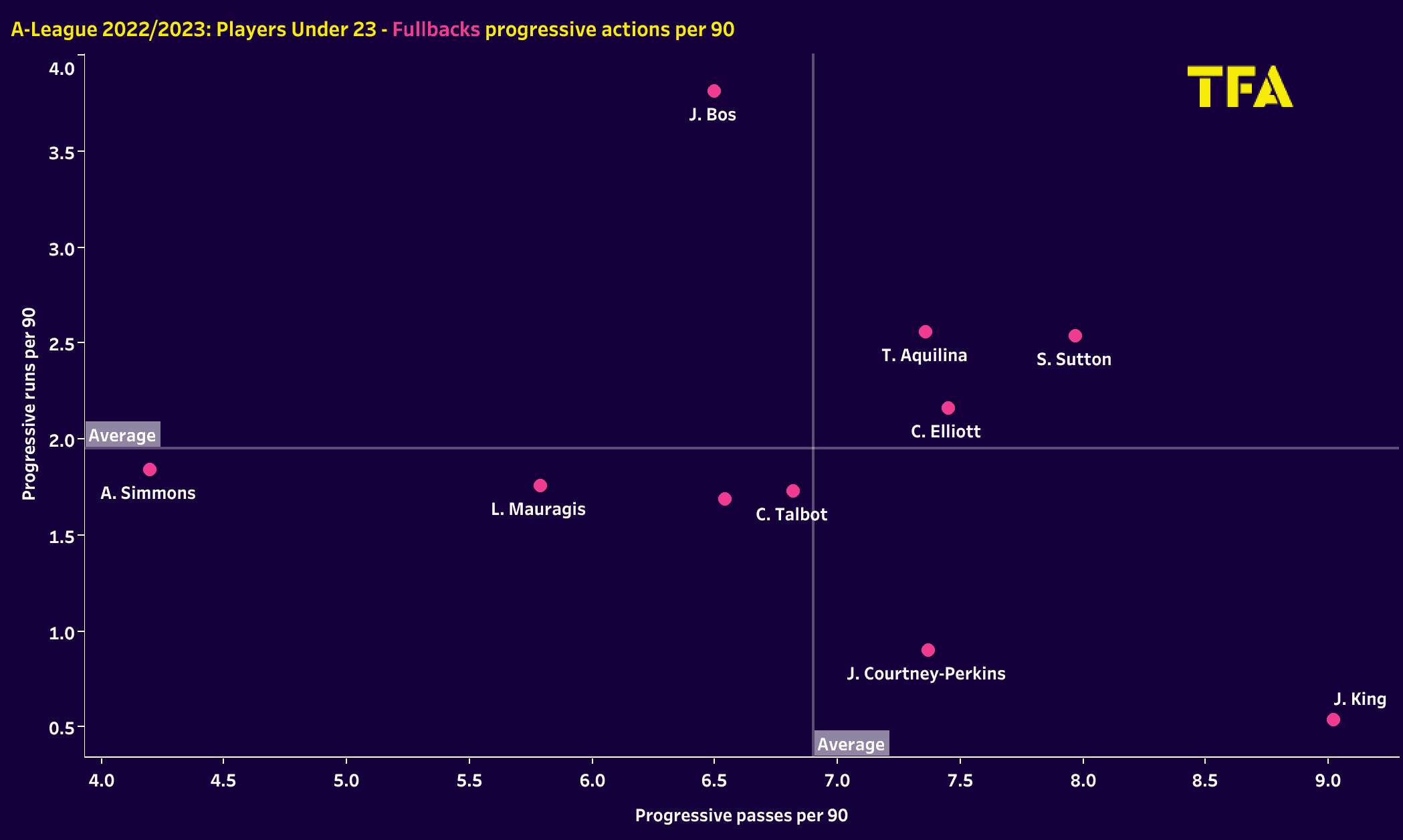
Let’s begin this dive into the data by examining how the U23 full-backs performed during the season. The data visual above shows us how the players in the sample group fared regarding their ball progression.
A full-back with good ball progression skills is an asset for a team as they can initiate attacks from deep positions. By receiving the ball from the centre-backs or the goalkeeper, they can drive forward with the ball, attracting opponents and creating spaces for their teammates. This enables the team to bypass the crowded midfield and launch swift counter-attacks or build-up play, catching the opposition off guard.
When the midfield is congested or marked tightly, the full-back can provide an alternative passing option on the flanks. By receiving the ball in wider areas, they can exploit the space available, stretch the opposition’s defence, and provide crosses into the box or cut inside to join the attacking play.
Jordan Bos is the standout player here. He averaged 6.50 progressive passes per 90 and 3.81 progressive runs per 90, suggesting he was a great attacking outlet for Melbourne City; this is further supported by the fact that Bos registered three assists from an xA of 1.87.
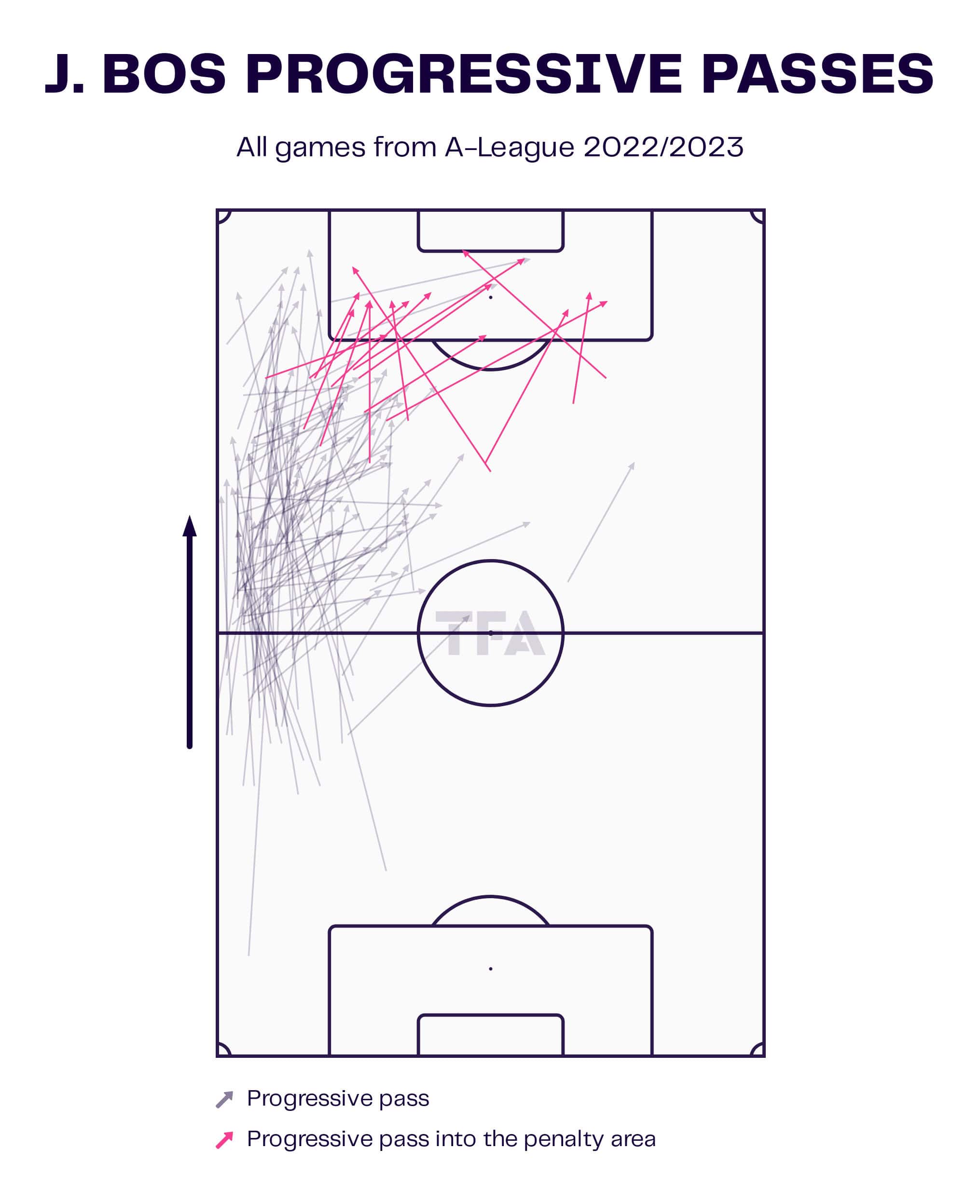
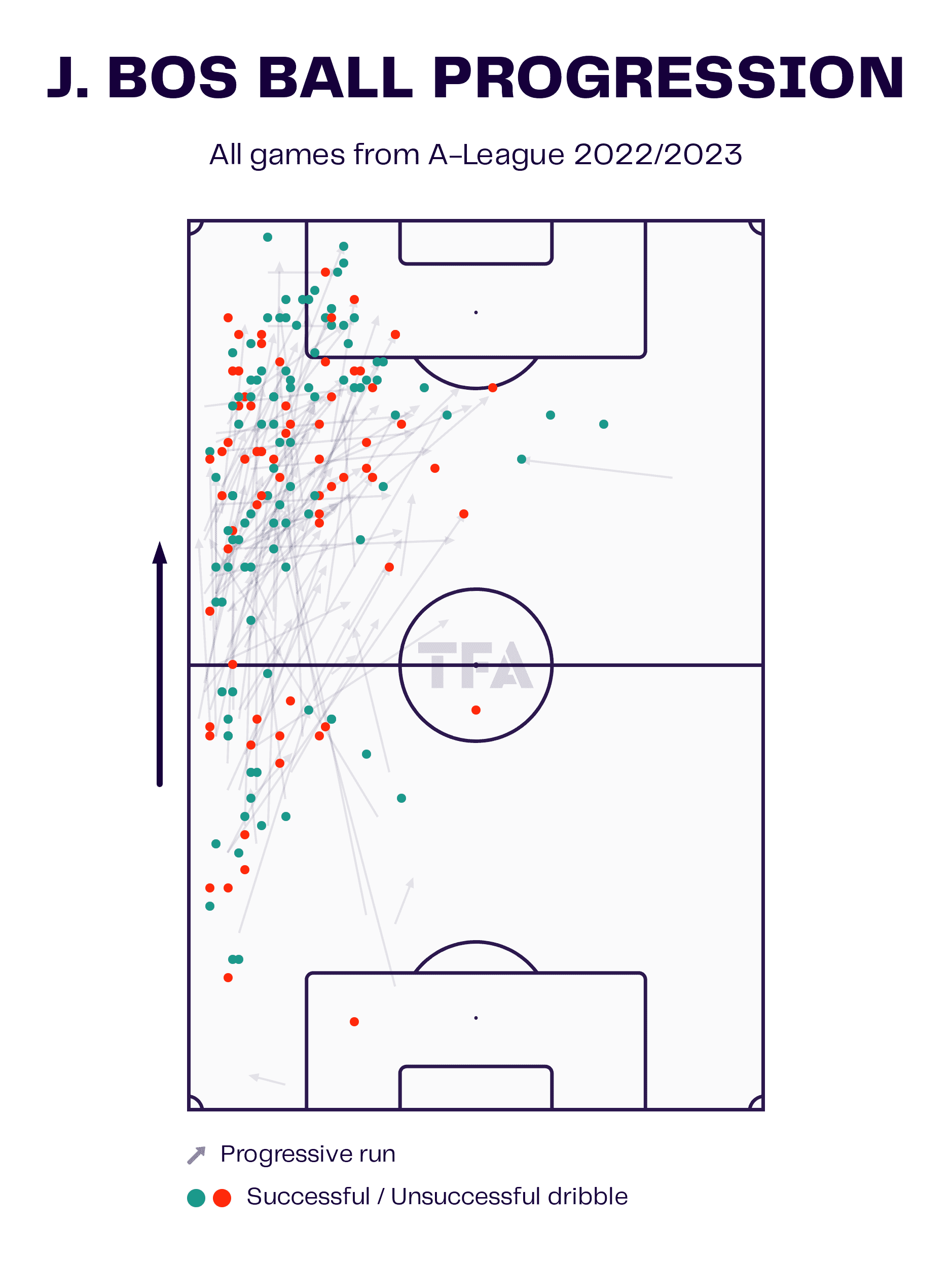
Analysing the data visuals above, we can delve into Bos’ ball progression in more detail. It becomes evident that when Bos entered the attacking third, he rarely made runs towards the byline; instead, he tended to dribble towards the penalty area. Most of his progressive passes into the penalty area occurred from the left half-space. Impressively, Bos boasted an average of 2.26 touches in the opposition penalty area per 90, the second highest among all players in the sample. Furthermore, his pass accuracy was the highest at 89.26%, indicating his reliable passing and ability to find his intended targets consistently.
It is essential to consider that Noah Smith had the third-fewest amount of minutes among the sample players, which naturally affected his statistics. In his 587 minutes of play, he averaged 10.43 progressive passes per 90. However, it is reasonable to assume that this number would have been slightly lower if he had played a few more games due to factors such as the quality of the opposition, fatigue, and specific defensive tactics employed by opponents.
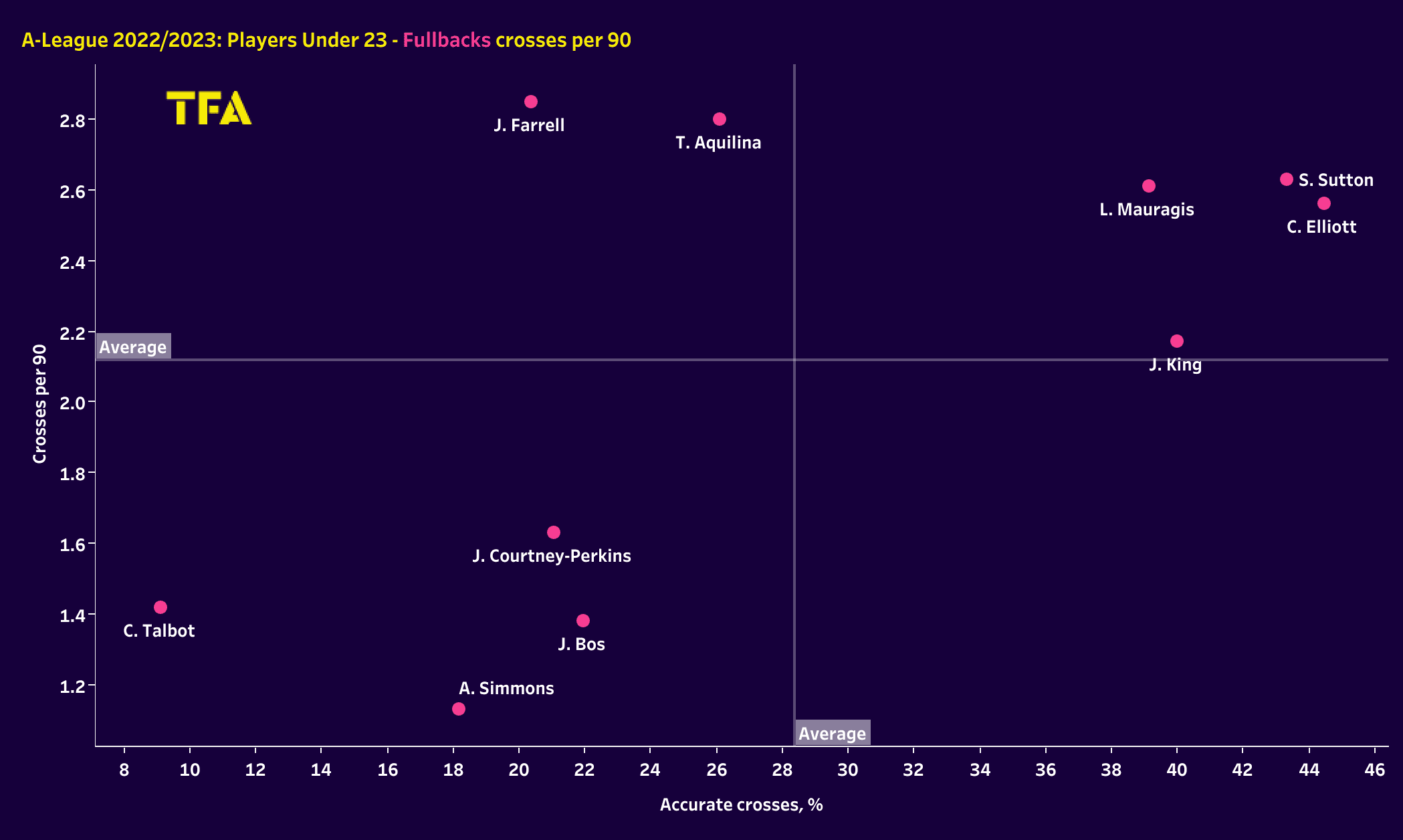
The number of crosses from full-backs can vary significantly based on the team’s style of play. However, examining the accuracy of crossing among players during the 2022/23 campaign is interesting. Sam Sutton from Wellington Phoenix stood out with an average of 2.63 crosses per 90 and a 43% accuracy rating. On the other hand, as expected, Jordan Bos had a relatively lower average of 1.38 crosses per 90 and struggled with accuracy in his crossing attempts.
Additionally, Jacob Farrell from Central Coast Mariners had the highest average number of crosses per 90 with 2.85, but his accuracy was notably lower at 20.37%. These statistics highlight the variation in crossing proficiency among full-backs. It is important to note that crossing accuracy can be influenced by factors such as the player’s technique, positioning, timing, and the movement of their teammates in the box. The accuracy of crosses can provide insights into a full-back’s ability to deliver quality service into the box, which can be crucial for attacking opportunities and goal-scoring chances for their team.
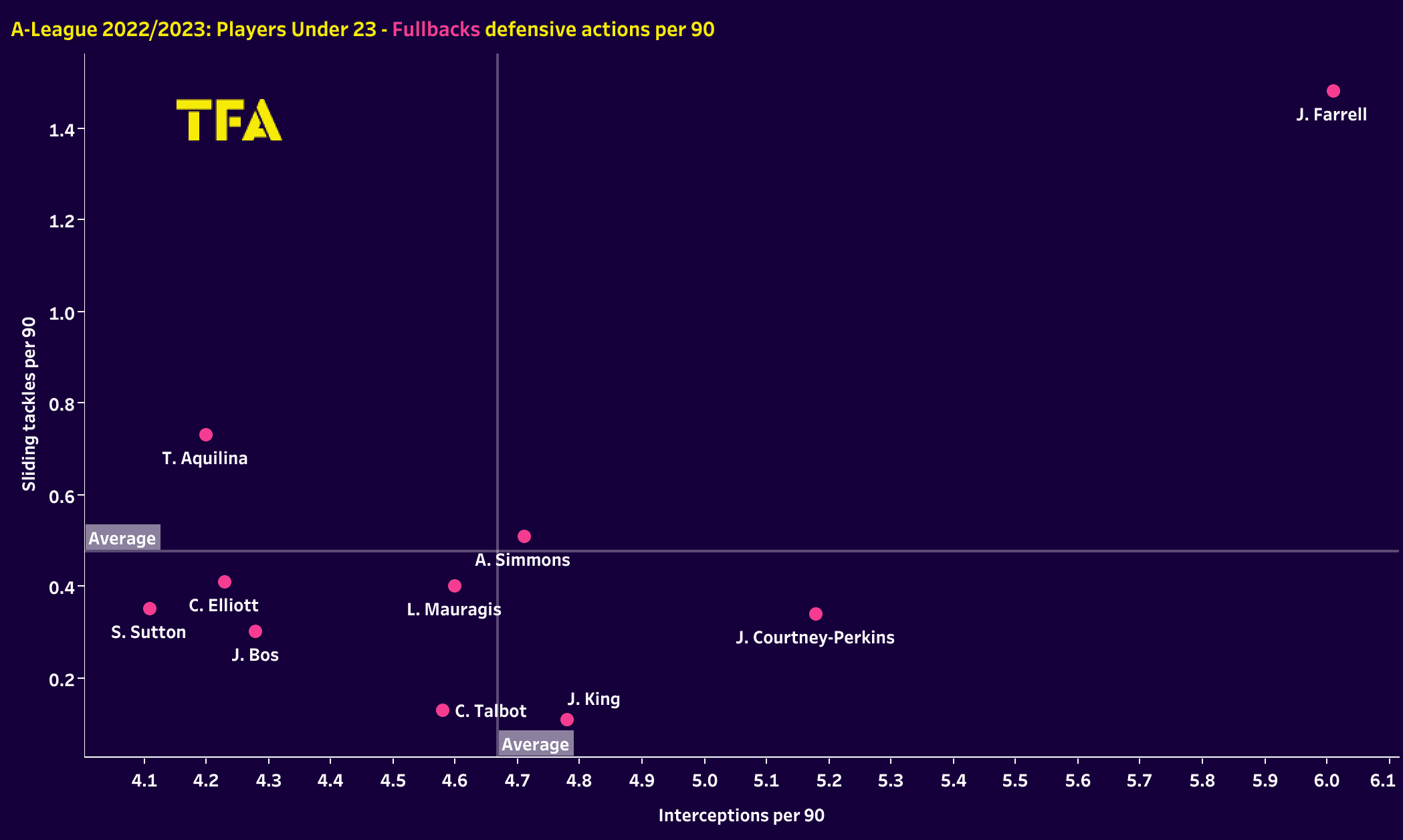
If we examine the number of sliding tackles and interceptions made by the group, we can observe that Farrell is the player who made the highest number of interceptions per 90 at 6.01 and the most sliding tackles per 90 with 1.48. His ability to make frequent interceptions showcases his astute reading of the game, allowing him to anticipate and disrupt the opponent’s passing moves effectively.
Another noteworthy player is Jordan Courtney-Perkins, who spent the season on loan at Brisbane Roar from Polish champions Raków Częstochowa. He impressively averaged 5.18 interceptions per 90, indicating his proficiency in understanding the game and positioning himself to intercept passes. Moreover, his tendency to stay on his feet and avoid sliding tackles suggests a disciplined approach, minimising the risk of conceding fouls that could be detrimental to his team’s defensive stability.
By excelling in defensive actions such as interceptions and displaying good decision-making regarding tackling techniques, both Farrell and Courtney-Perkins contribute significantly to their respective teams’ defensive efforts while mitigating potential risks associated with fouls and penalties.
Central defenders
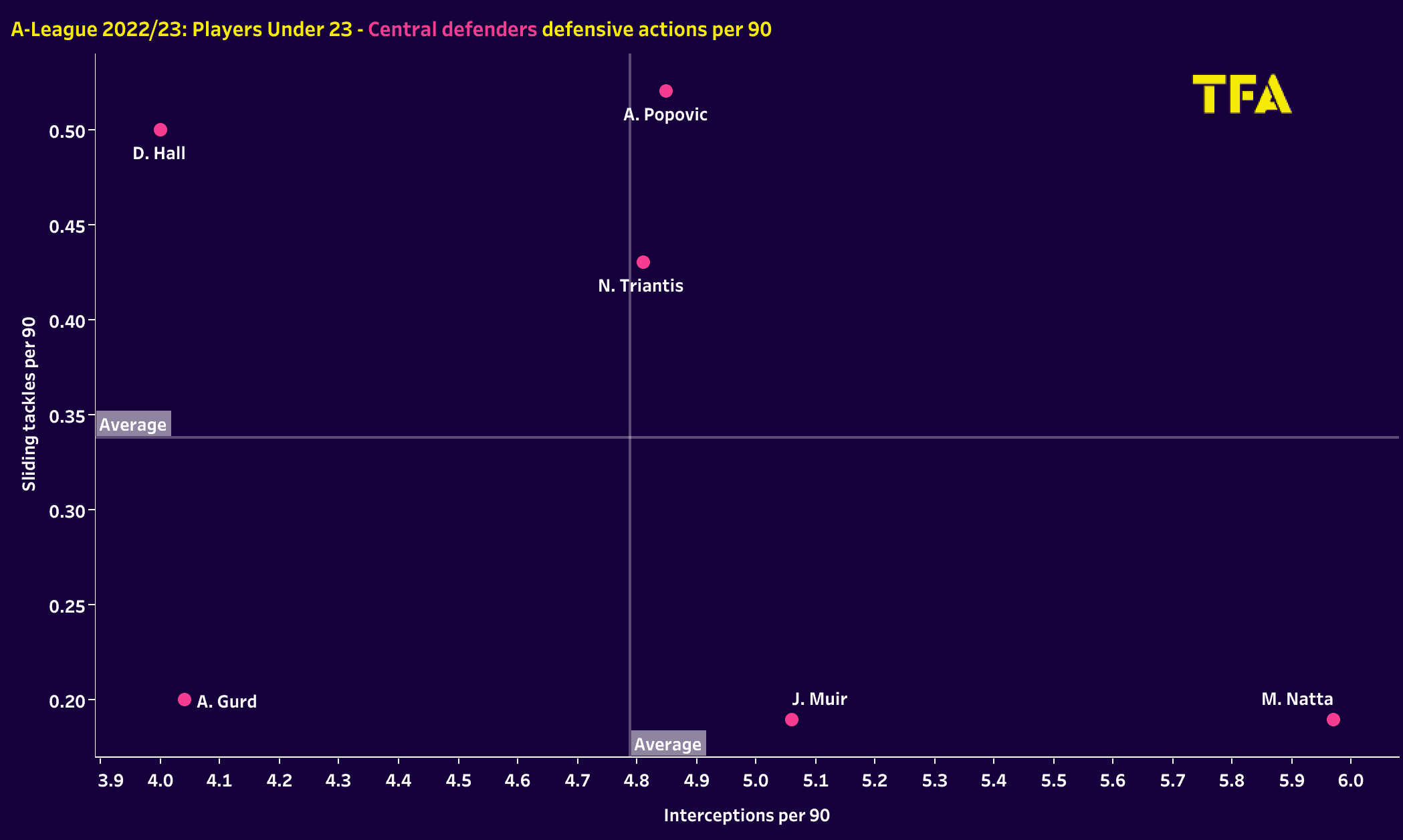
Now, let’s move on to look at the central defenders. We can see that Alexandar Popovic of Adelaide United played 18 games last season, averaging 4.85 interceptions per 90 and 0.52 sliding tackles per 90. Popovic, Jacob Muir, Nectarios Triantis and Mark Natta rank highly in the number of interceptions, the latter being particularly impressive.
This is desirable in modern-day football as interceptions are generally safer and carry less risk of fouling the opponent. Sliding tackles, while effective when timed perfectly, can also be risky. If mistimed or executed poorly, sliding tackles can result in fouls, penalties, or on occasion, red cards, which can significantly impact the team’s defensive stability and potentially lead to dangerous set-piece situations for the opponent.
Moreover, interceptions are more proactive. Instead of waiting for the opponent to come within sliding tackle range, interceptions involve reading the game, anticipating the opponent’s moves, and actively intercepting passes or cutting off passing lanes. This proactive approach enables the team’s central defenders to prevent attacks from fully developing. It allows for a more controlled defensive strategy, minimising the chances of leaving gaps or getting beaten in one-on-one situations.
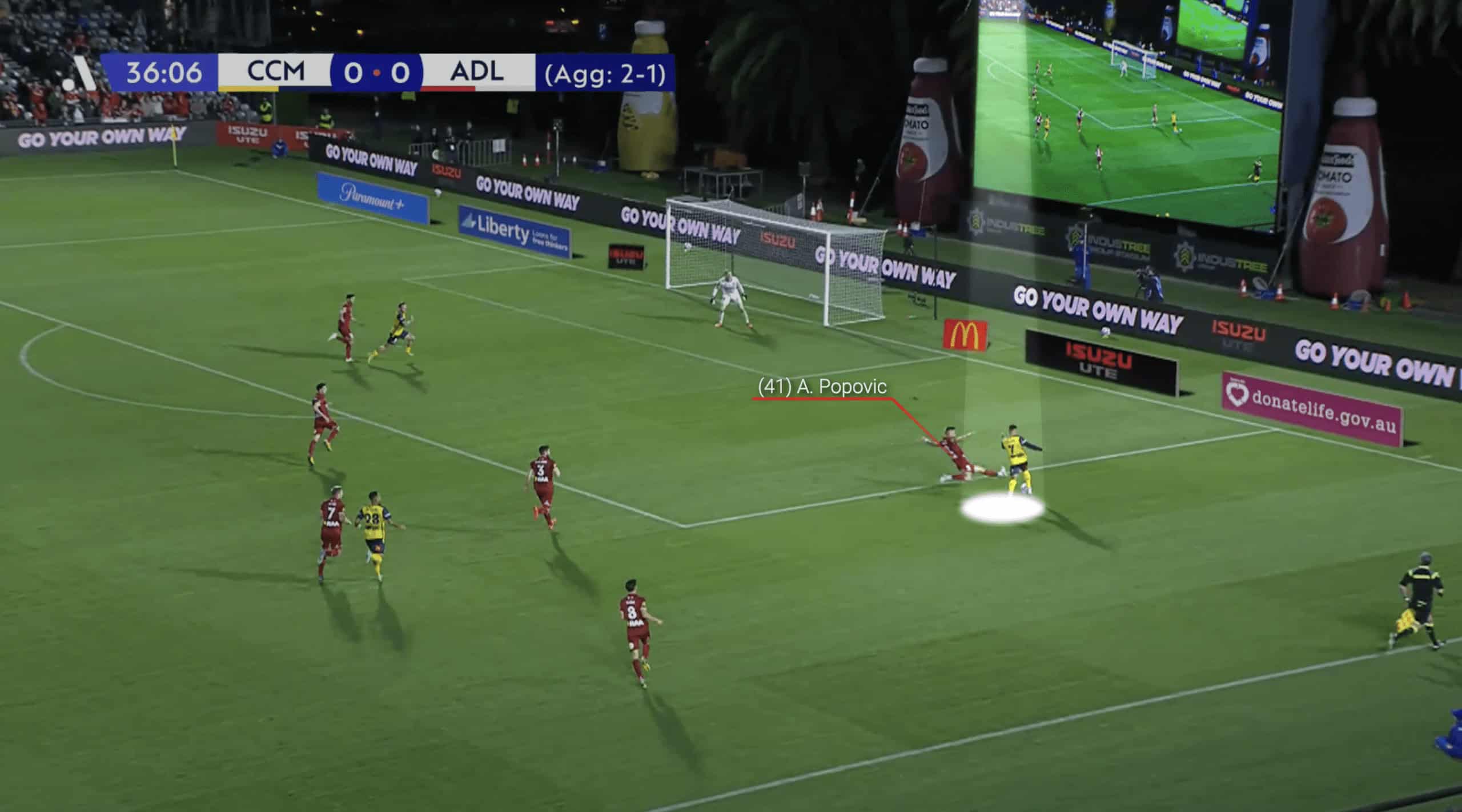
In the image above, we can observe Popovic executing a flying sliding tackle in a dangerous area. The proximity to the penalty area increases the risk of conceding a penalty, although the foul is ultimately awarded just outside the box. Nonetheless, this remains a dangerous situation, as the ensuing free kick could potentially result in a goal for the opposing team. There was no real reason for Popovic to resort to a ground tackle in this scenario, as he had matched Silvera’s pace and could have guided him towards the byline, forcing him to either backtrack or attempt a cross.
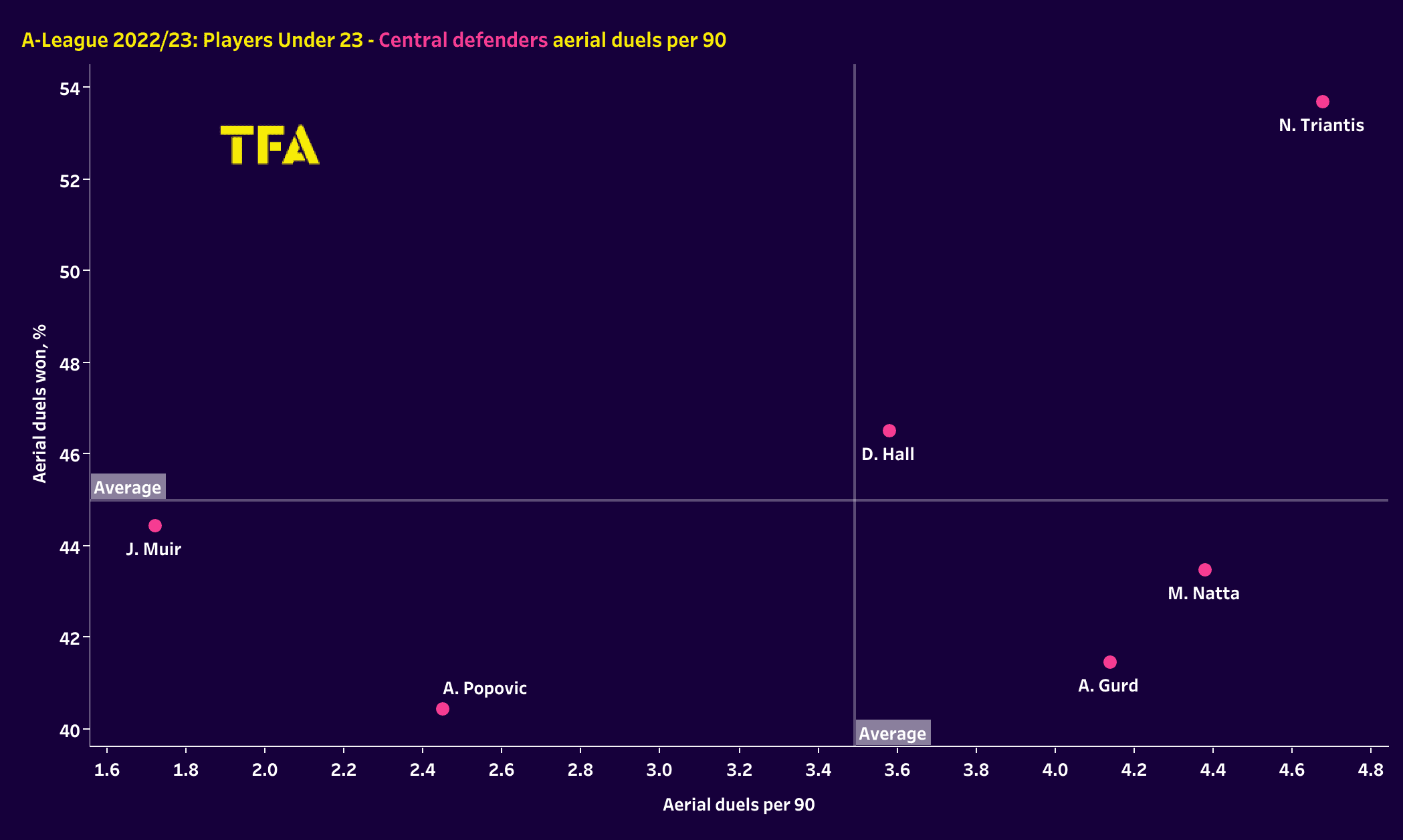
Interestingly, Popovic didn’t fare too well in terms of the number of aerial duels he won, only 40.43%, and this could be a weakness in his game that opponents could look to target in future. Meanwhile, Nectarios Triantis appears to have excelled in this metric and was very reliable in the air, which means he provided a solid defence for Central Coast Mariners.
There are a few reasons why Popovic didn’t do well in the aerial battle, such as the opposing players he faced might have possessed superior aerial ability, such as height, jumping ability, or positioning. This could have made it more difficult for the central defender to win aerial duels consistently, especially when facing taller or physically dominant opponents.
Secondly, his timing or technique in aerial duels might have been suboptimal. Timing is crucial when challenging aerial balls, and mistiming the jump or misjudging the flight of the ball can result in losing duels. Additionally, poor technique in terms of body positioning, using arms effectively, or directing the header can also lead to a lower success rate in aerial duels.
Furthermore, the opposing team’s style of play or tactical approach might have limited the number of aerial duels the young central defender engaged in. If the opposing team focused more on playing on the ground and building up play through shorter passes, Popovic might have had fewer opportunities to contest aerial duels.
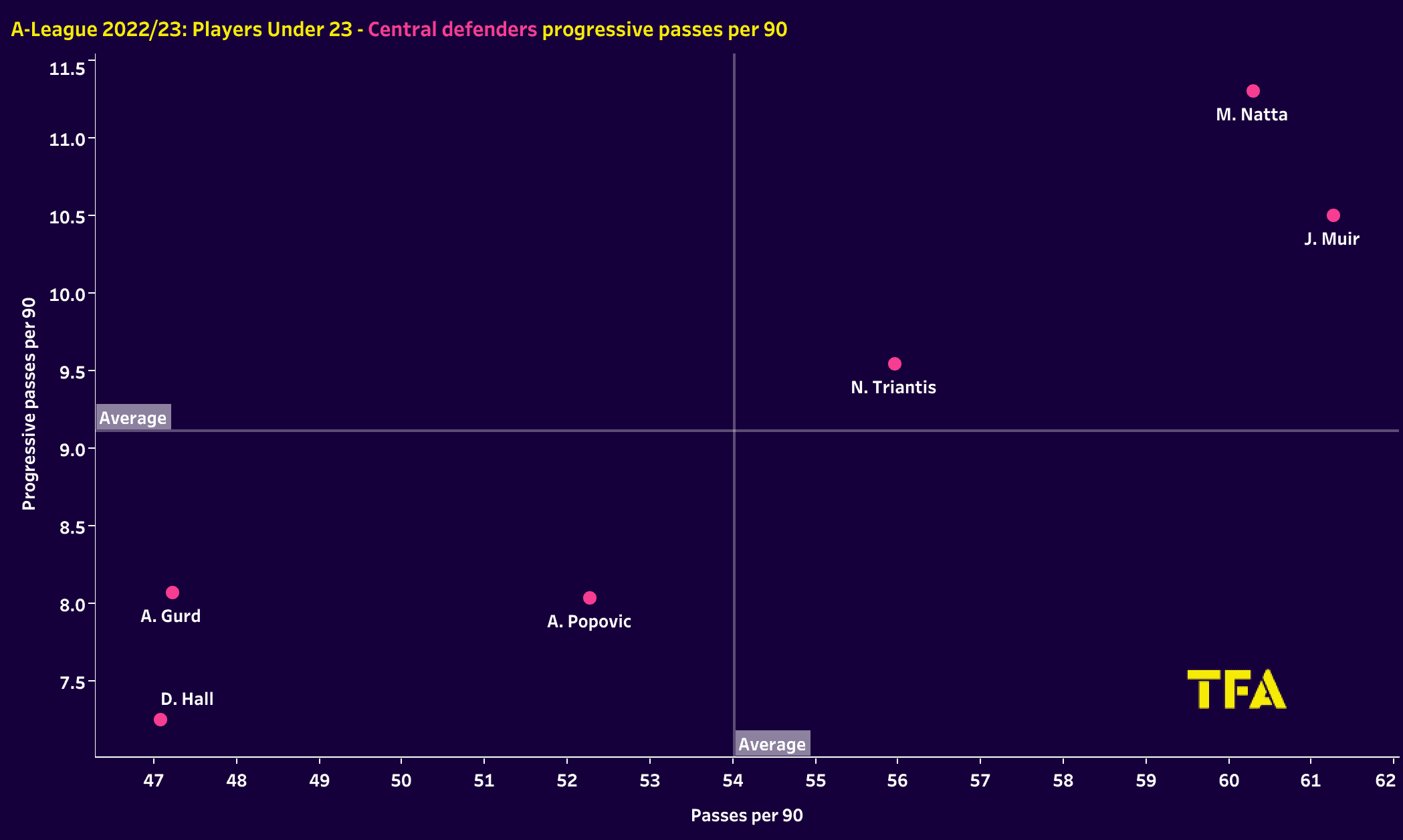
The modern game of football places increasing importance on ball-playing central defenders due to tactical changes and advancements. Many teams now adopt a possession-based style of play, where the central defenders are involved in intricate passing sequences, helping to maintain possession and dictating the tempo of the game. By being comfortable on the ball and having the vision to play progressive passes, the central defenders become integral to the team’s overall possession-oriented approach.
The data visual highlights the impressive performance of Mark Natta and Jacob Muir in terms of the number of progressive passes they played per 90. Natta stood out with an average of 11.3 progressive passes per 90, showcasing his ability to drive the ball forward and contribute to the team’s attacking play. Muir also displayed a commendable performance in this aspect, with 10.50 progressive passes per 90.
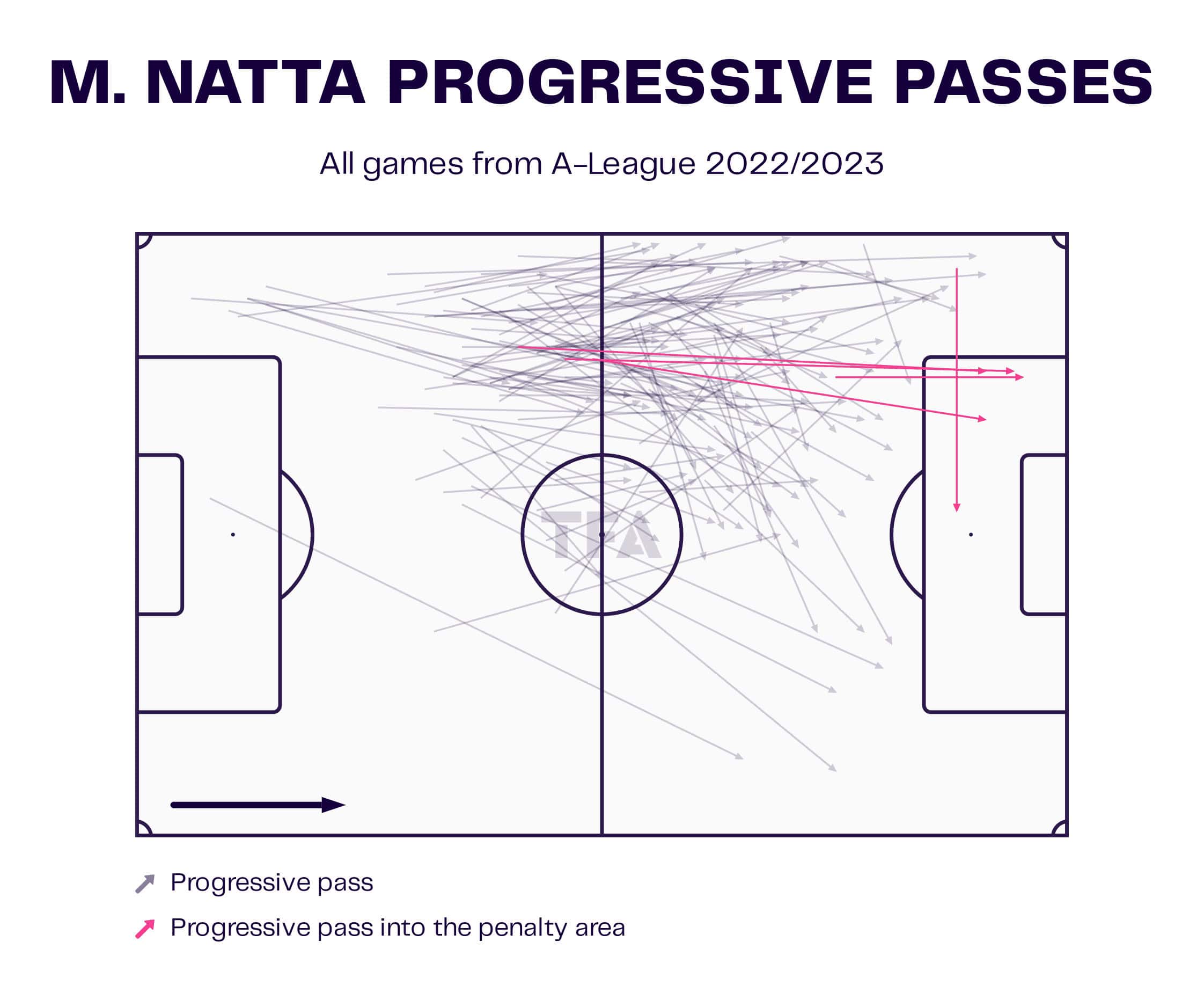
Focusing on Natta, the data visual above shows us where on the pitch his progressive passes took place. Natta’s ability to play progressive passes down the left wing and into central areas could add an extra dimension to Newcastle Jets’ attacking strategy in the future.
He has the potential to become a very important player, as he is capable of initiating attacks from deep positions. His ability to progress the ball forward and make incisive passes into midfield or the attacking third can add an element of disorganisation to the opposition’s defensive structure and create numerical advantages in advanced areas.
Midfielders
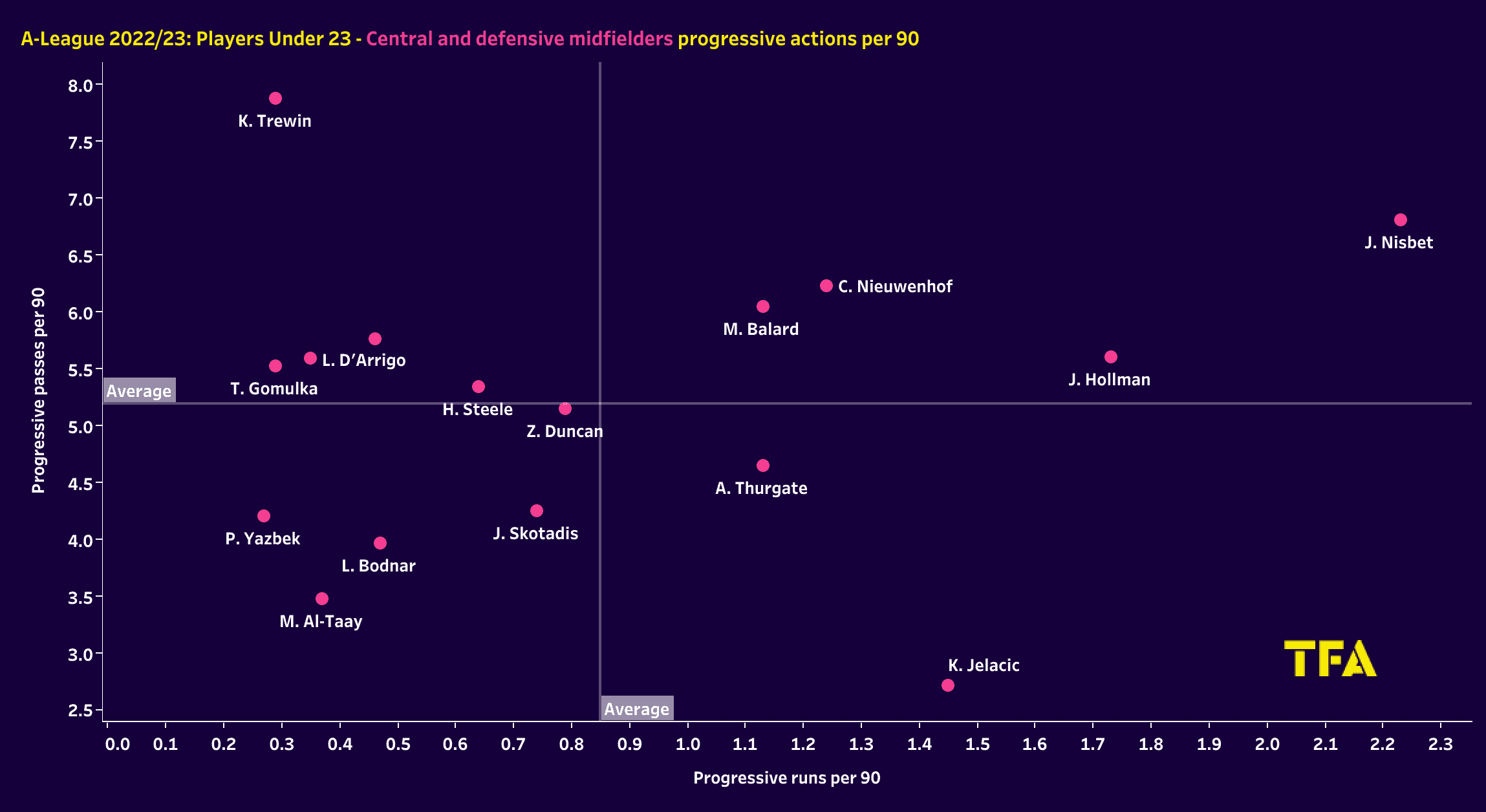
If we now turn our attention to how the central and defensive midfielders performed, we can use the data visual above to analyse their progressive actions per 90 minutes. Joshua Nisbet lined up as the left-sided central midfielder for Central Coast Mariners in their 4-4-2 formation; he averaged 2.23 progressive runs per 90 and 6.81 progressive passes per 90, suggesting he had creative licence to get forward to impact the attack.
We also must highlight Keegan Jelacic, who has recently signed for Belgian side Gent. The 20-year-old is primarily a central midfielder. However, during the 2022/23 campaign, he played a few games as a winger, which will have impacted these metrics and may account for why his number of progressive runs per 90 are quite high.
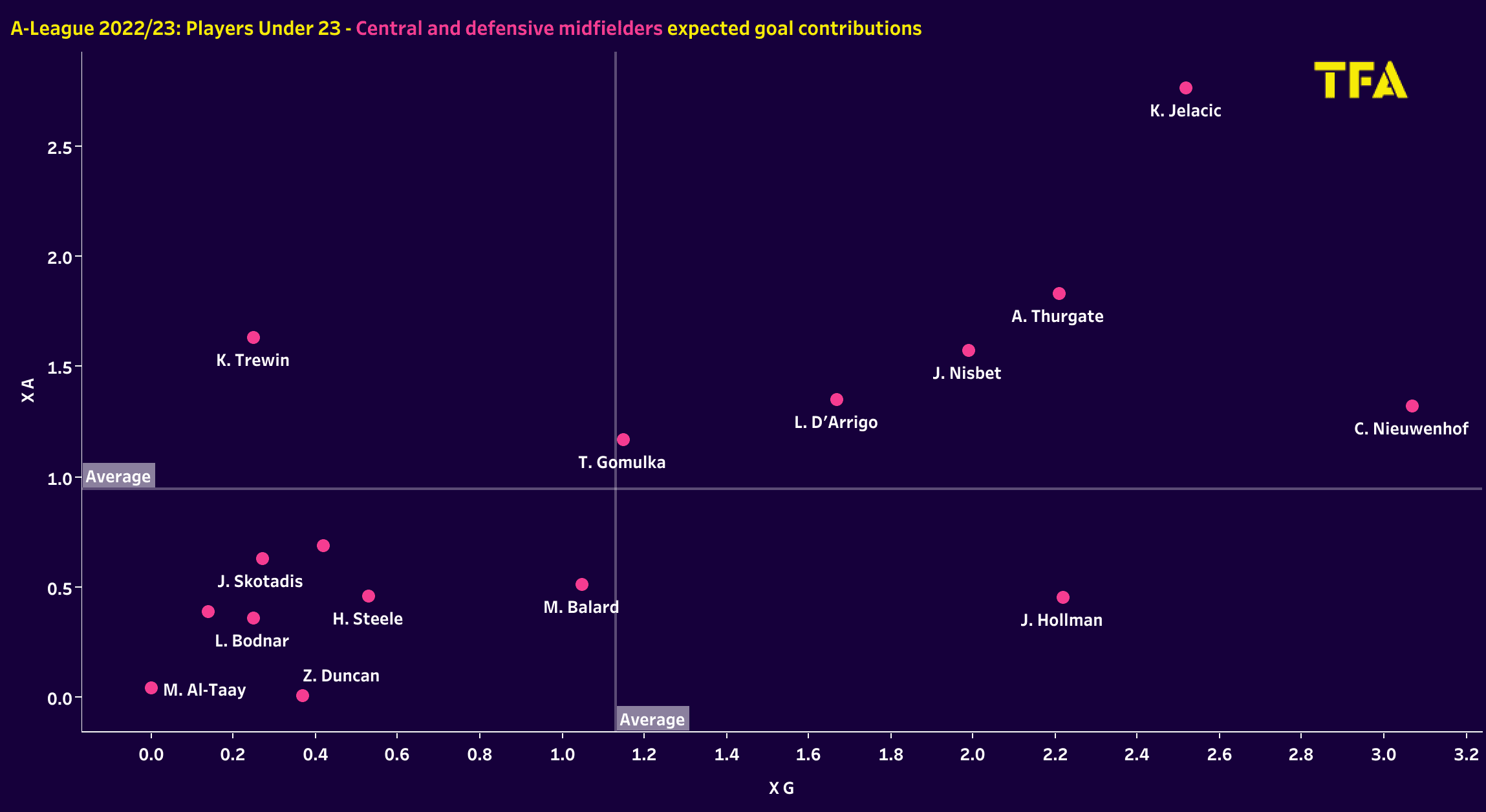
Looking at the number of expected goal contributions throughout the season from our sample of central midfielders, it is evident that Jelacic ranks highly in this metric. However, we must consider the impact of the 6-10 games he played as a winger, which could have affected his performance. He scored three goals and provided two assists during the league campaign last year, with an xG of 2.52 and an xA of 2.76. These numbers can be considered respectable for a Perth Glory side that struggled for most of the season and ultimately finished in 9th place.
On the other hand, Taras Gomulka had a disappointing season at Brisbane Roar. Despite having an above-average expected goal contribution compared to other U23 midfielders, he failed to register any goals or assists throughout the season. Angus Thurgate managed to score two goals but did not pick up any assists, despite having an xA of 1.8. It’s important to note that various factors on the pitch can influence these statistics. For example, Thurgate may have made a perfect pass, but his teammate failed to convert it into a goal, resulting in him not being credited with an assist.
Among the midfielders, Calem Nieuwenhof stood out as the best performer in terms of goal contributions, scoring four goals and providing one assist throughout the season. Nieuwenhof played as a central midfielder in Western Sydney Wanderers’ 4-4-2 system, alongside former Manchester United player Morgan Schneiderlin. This indicates that the younger player was given the opportunity to participate in the team’s attacking play, while Schneiderlin tended to adopt a deeper position to provide defensive cover.
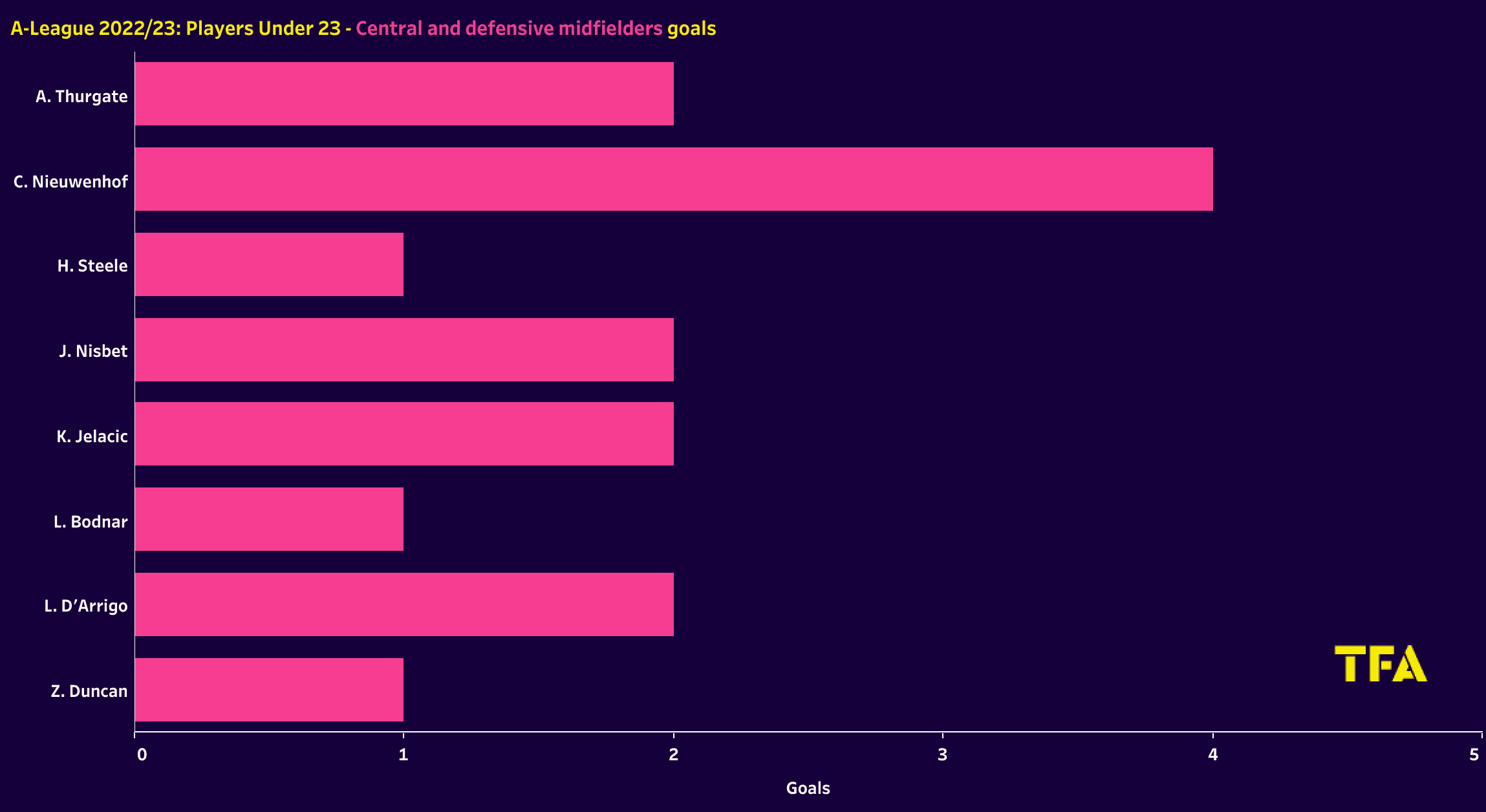
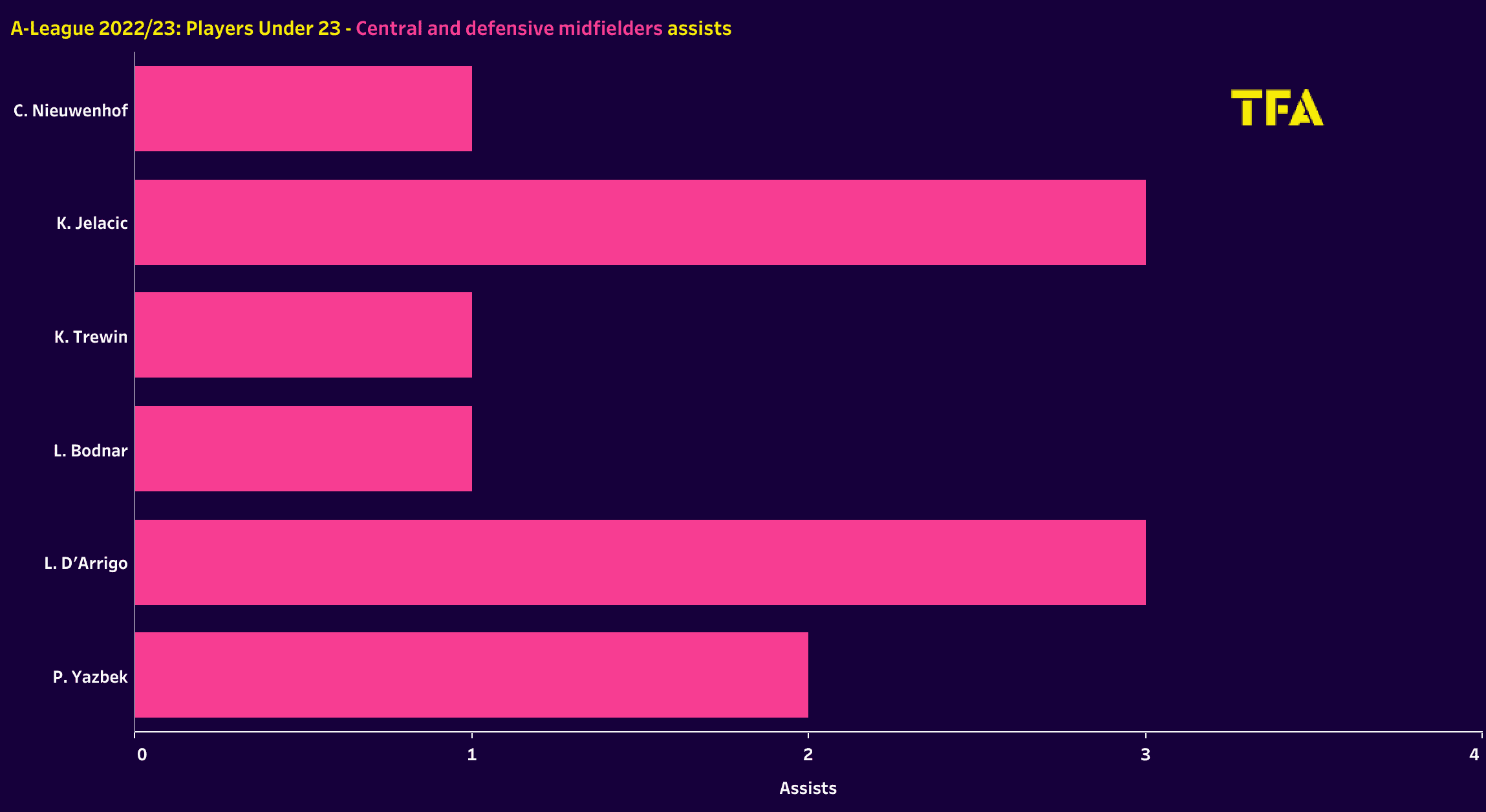
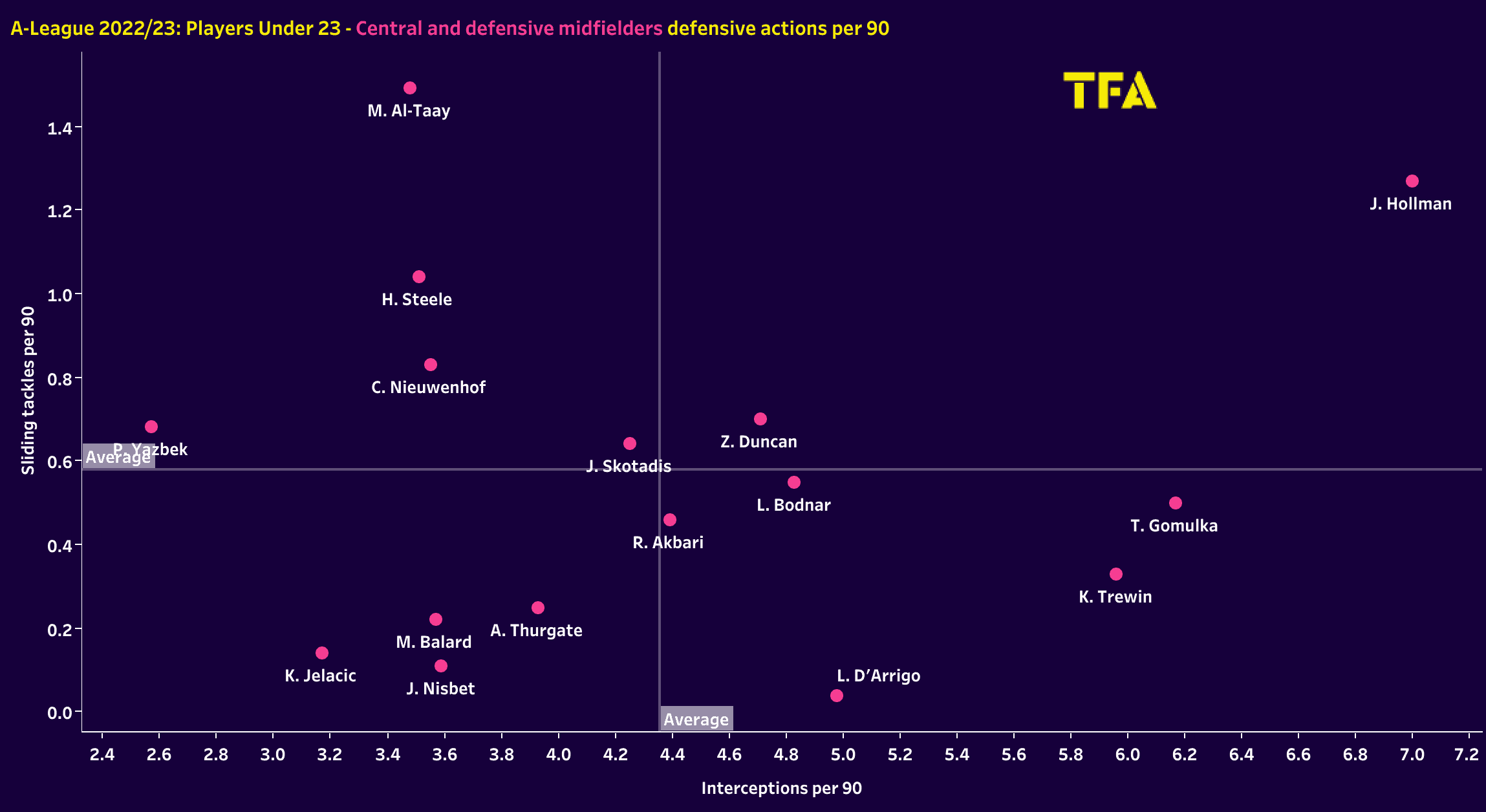
When considering the defensive contributions of the players, it is noteworthy that Jake Hollman ranks the highest in terms of the number of sliding tackles and interceptions per 90. Playing for Macarthur, who had a challenging season and finished at the bottom of the league, Hollman stood out defensively. Hollman’s high rankings in sliding tackles and interceptions per 90 showcase his tenacity and ability to effectively disrupt the opposition’s play. Despite Macarthur’s struggles as a team, his defensive contributions demonstrate his commitment and determination on the field. On the other hand, it is unsurprising to see Jelacic scoring low in these metrics considering his attacking nature as a player.
Attackers – Wingers / Attacking Midfielders
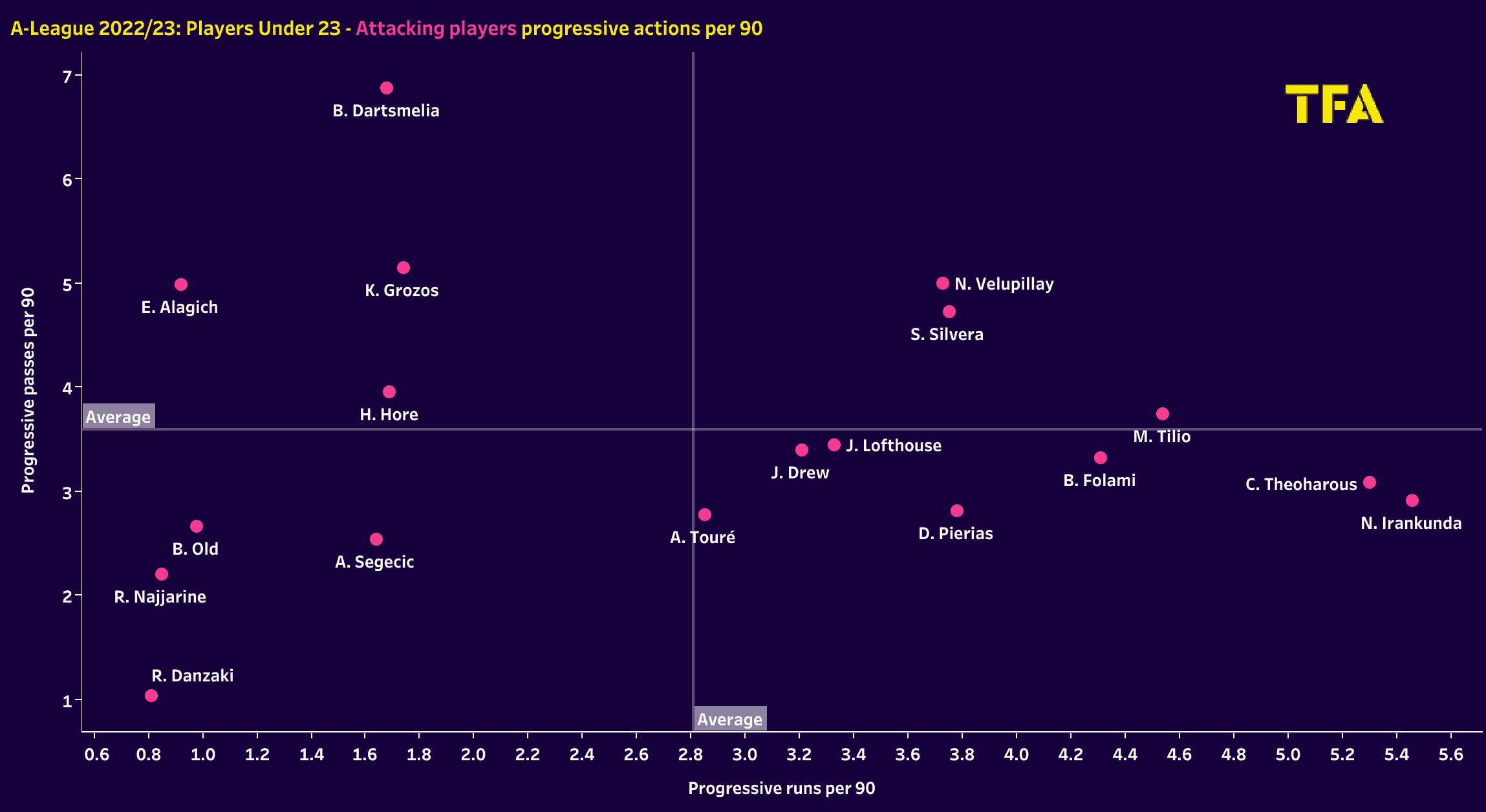
Moving on, analyse how the attacking players performed (wide players/ wingers and attacking midfielders). Of course, we must talk about Marco Tilio, who recently signed for Celtic from Melbourne City. The winger displayed good ball progression, averaging 3.74 progressive passes per 90 and 4.54 progressive runs per 90. Additionally, Sam Silvera, who has recently joined EFL Championship side Middlesbrough, averaged 4.72 progressive passes per 90 alongside making 3.75 progressive runs per 90.
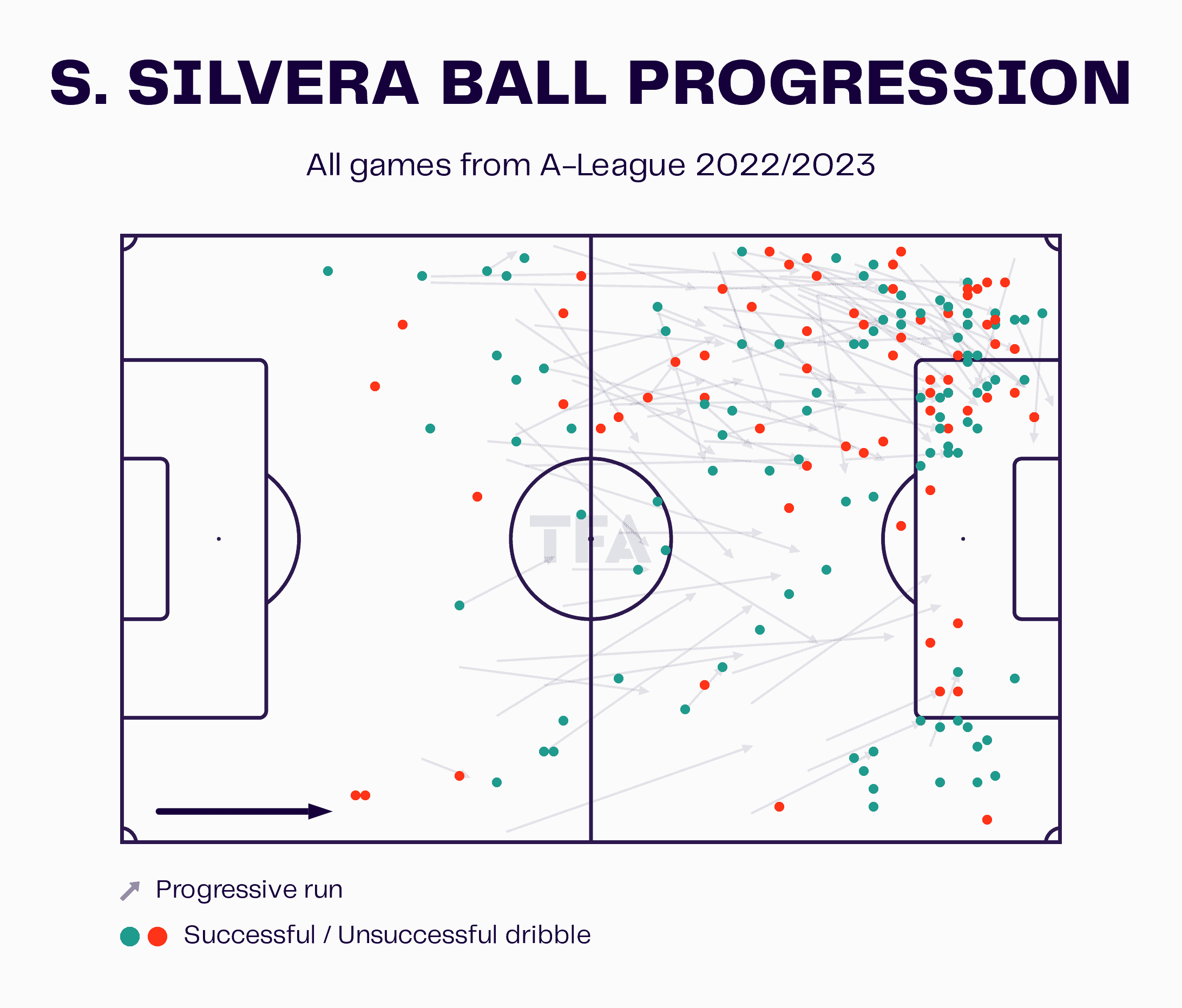
The data visual above allows us to see why Silvera was so integral to Central Coast Mariners last season. We can see that although he was active on both wings, Silvera primarily occupied a position on the left. We can also understand that Sam Silvera preferred to cut inside from the left wing rather than acting as an out-and-out winger. He would often drift into more central areas, allowing the team to retain a compact shape when required and make him an outlet should a long pass be played behind the opposition’s defensive line.
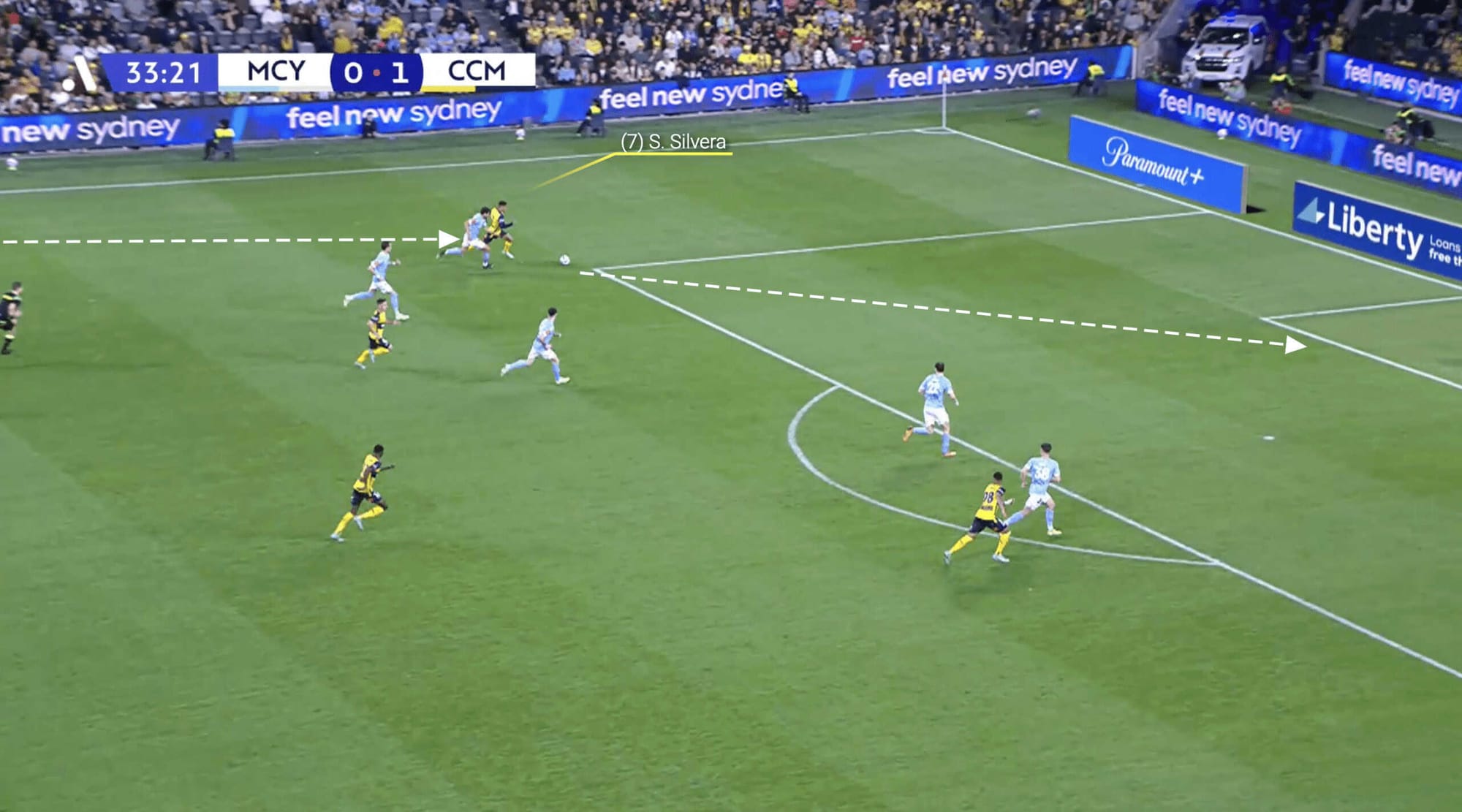
In this instance, the new ‘boro signing showcases his skill by initiating an inverted run from the left wing while carrying the ball forward. Exploiting his speed, he surpasses his marker and penetrates the opposition’s penalty area. With composure, he unleashes a trademark powerful drive, ultimately securing a goal for Central Coast Mariners.
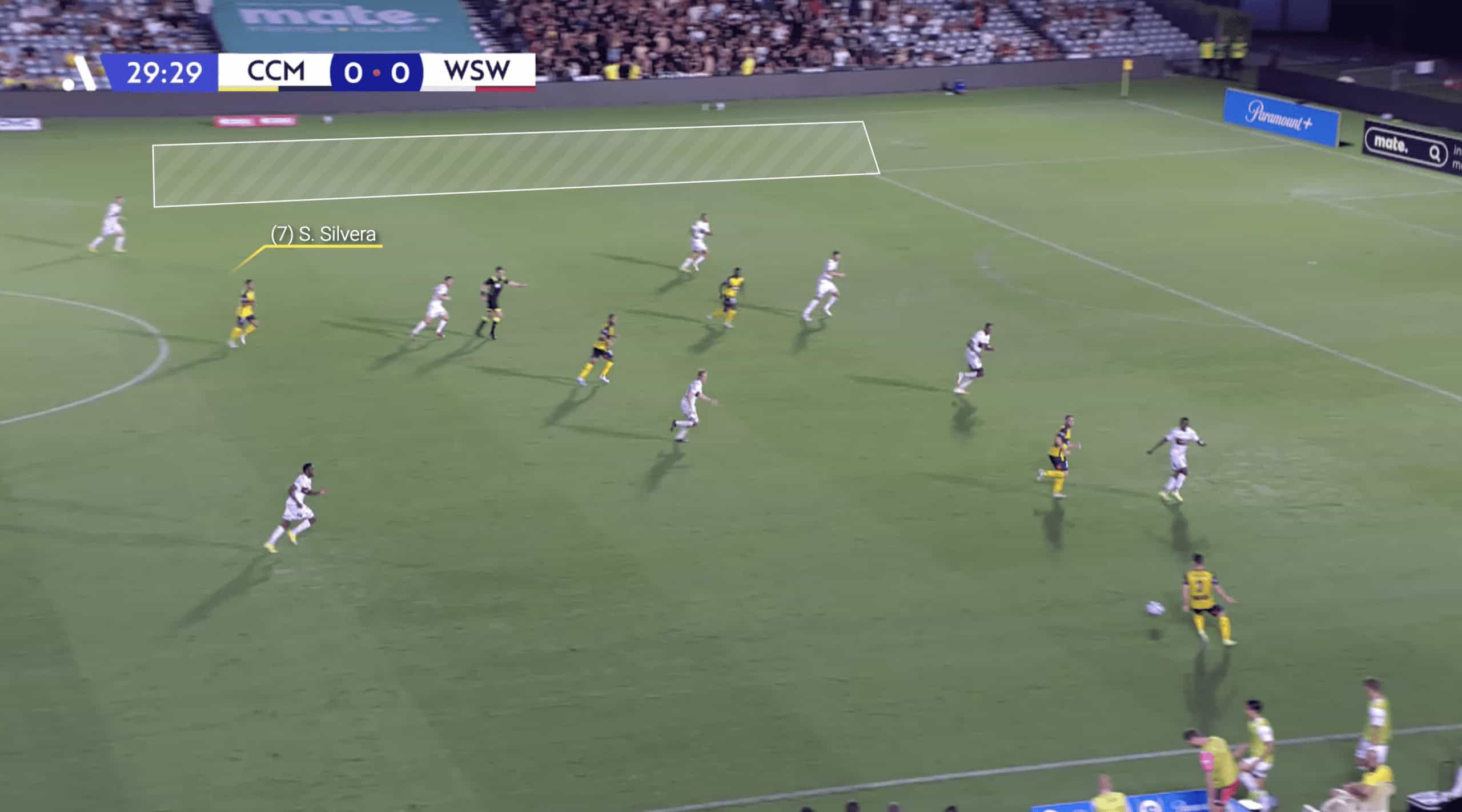
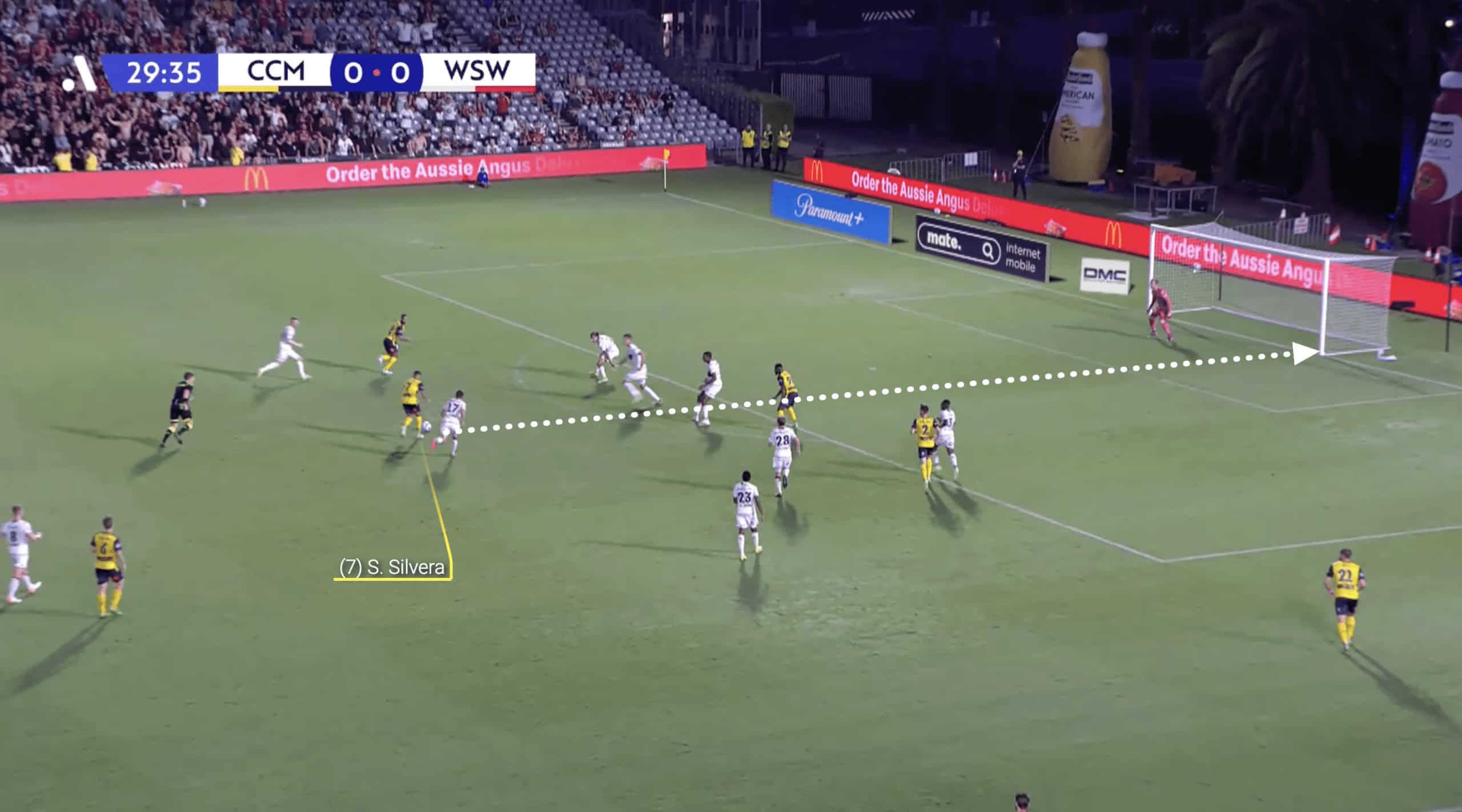
These images illustrate how Silvera actively sought to occupy central areas, leaving significant space available on the left wing. This positioning creates an advantageous situation for overlapping runs from the full-back, who would likely face minimal marking in this scenario. In the depicted situation, Silvera receives the ball in the midfield area and skillfully takes a couple of touches to create additional space. He then confidently releases a low and forceful shot towards the goal, showcasing his ability to generate power and accuracy in his strikes.
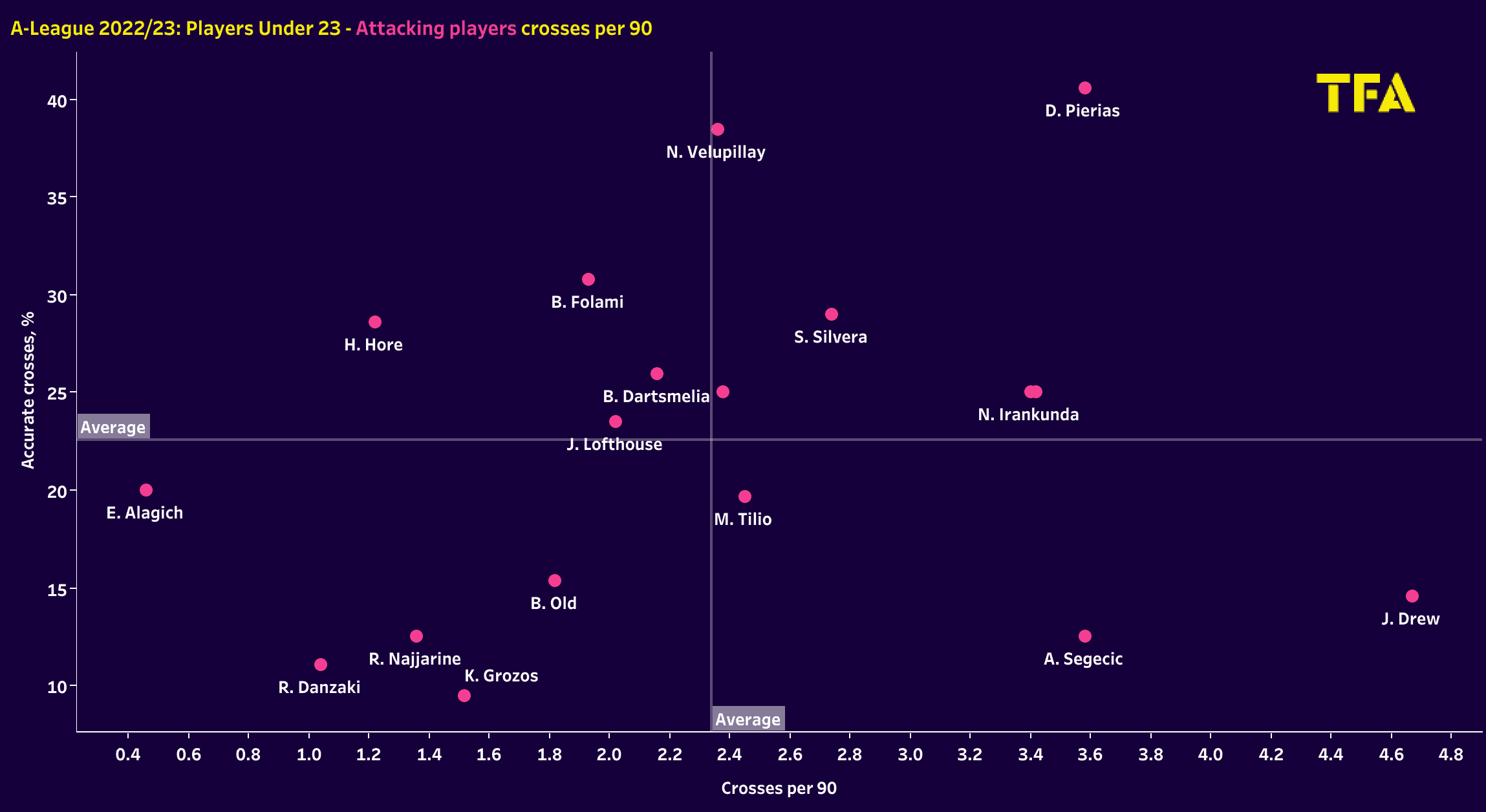
Here, we will look into the number of crosses per 90 and the accuracy of the sample group’s crossing abilities. Whilst the number of crosses a player executes is mainly dependent on the team’s style of play, it is a valuable skill to have, as by delivering accurate crosses, the player can create goal-scoring opportunities for their teammates and contribute to the team’s overall offensive success.
Of course, Sam Silvera performs above average compared to his peers, with 2.74 crosses per 90 and a 29% accuracy rating. Dylan Pierias was the standout player in these metrics, averaging 3.58 crosses per 90 with an overall accuracy rating of 40.5%. Marco Tilio diy put a fair amount of crosses in, but they were largely inaccurate. The same can be said for Segecic and Drew, as shown above.
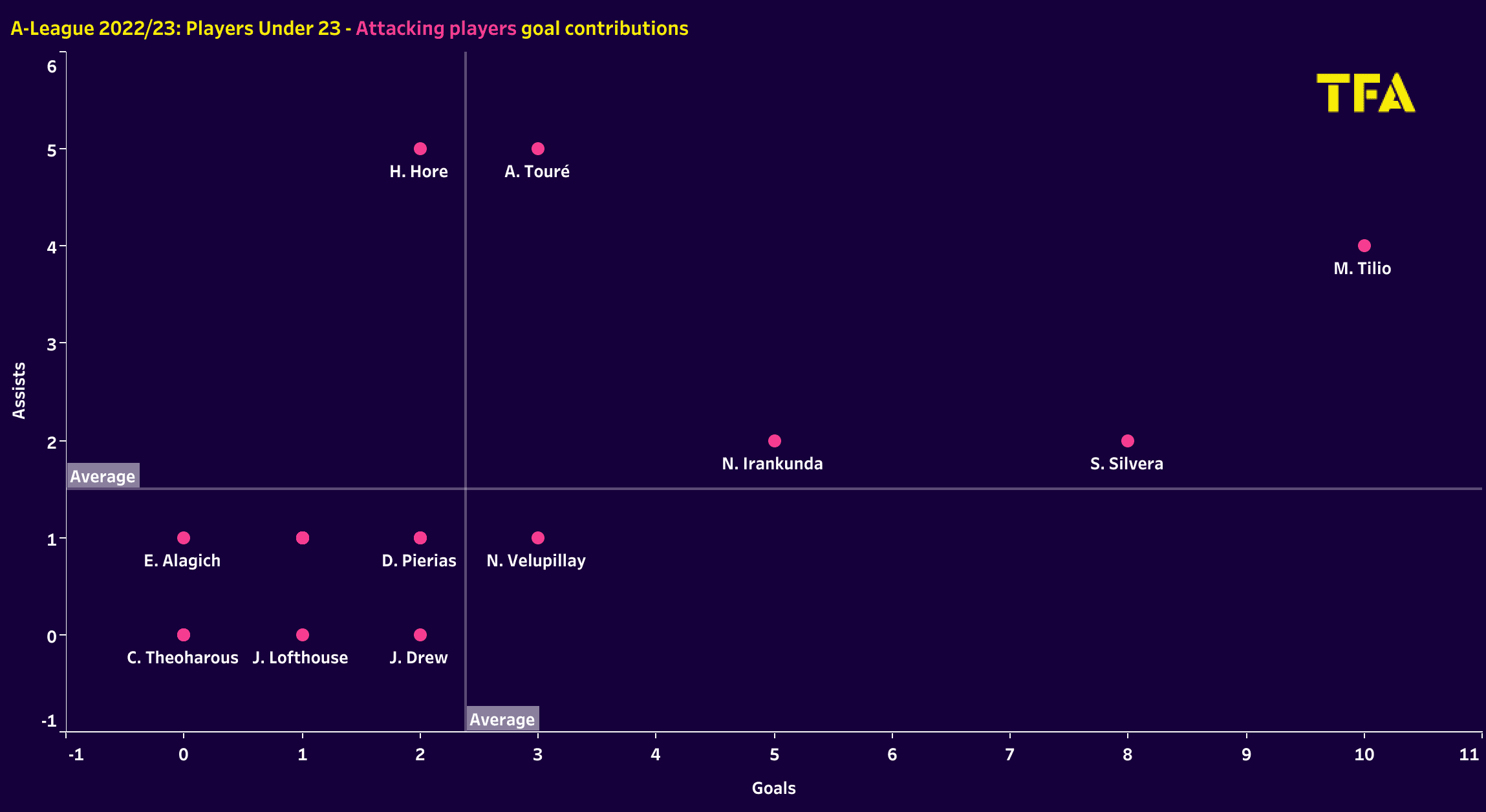
Marco Tilio undoubtedly contributed the most as he aided Melbourne City’s cause with 10 goals from an xG of 7.25 and chipped in with four assists from an xA of 3.4. The aforementioned Sam Silvera ranked highly here too. He bagged eight goals from an xG of 4.16, indicating that he scored some lower percentage chances. As we saw above, he likes to take long shots from outside the area, which is less likely to hit the back of the net; hence, his xG is lower.
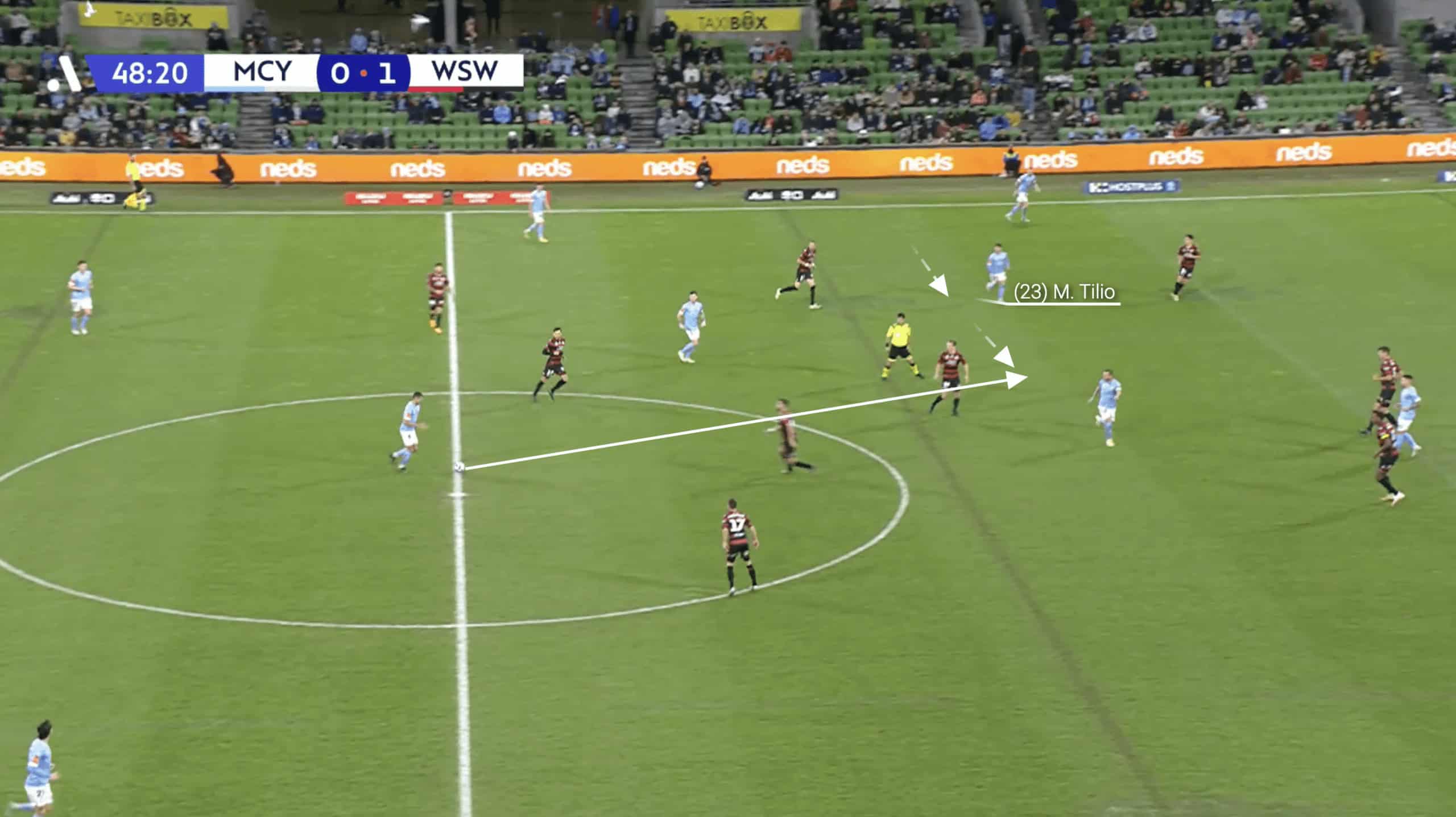
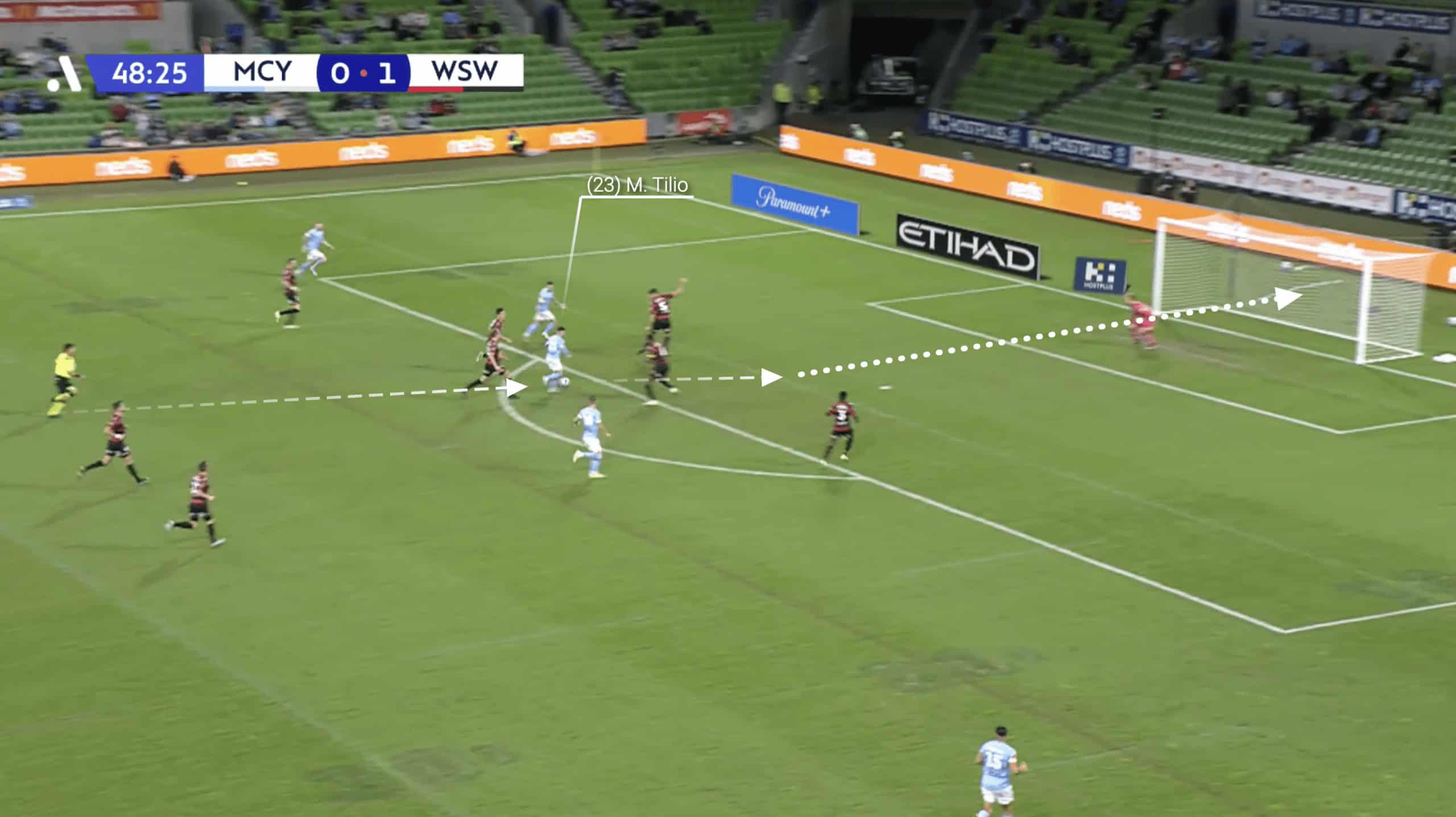
Tilio’s style of play bears a resemblance to that of Silvera, as observed in the above images, where he demonstrates a tendency to drift in from the left wing towards the central area to receive the ball. This movement played a significant role in enabling the left back, Jordan Bos, to make numerous progressive runs down the left wing, benefiting from the space created by Tilio’s off-the-ball positioning. As depicted in the image, Tilio exhibits excellent ball-carrying skills, utilising his close control and quick footwork to create enough space to execute a shot.
Centre forwards

Looking at how the centre forwards fared, we can see that Noah Botić was the best performer as a goalscorer. The Western United man scored six goals in 21 appearances last season, whilst Nicolas Milanovic scored five in 2 for Western Sydney Wanderers. Whilst no centre-forward under the age of 23 scored many goals, this should not be of great concern.
Younger forwards may have limited playing time or opportunities to showcase their goal-scoring abilities. For example, Botić may have made 21 appearances, but that translates to 992 minutes. Fernando Romero played only 506 minutes, placing him at the significantly lower end of our sample of players with over 500 minutes. Additionally, these players compete with more established and experienced forwards for a place in the starting lineup. Coaches are also looking to prioritise their development by gradually integrating them into the team, which can result in limited playing minutes.
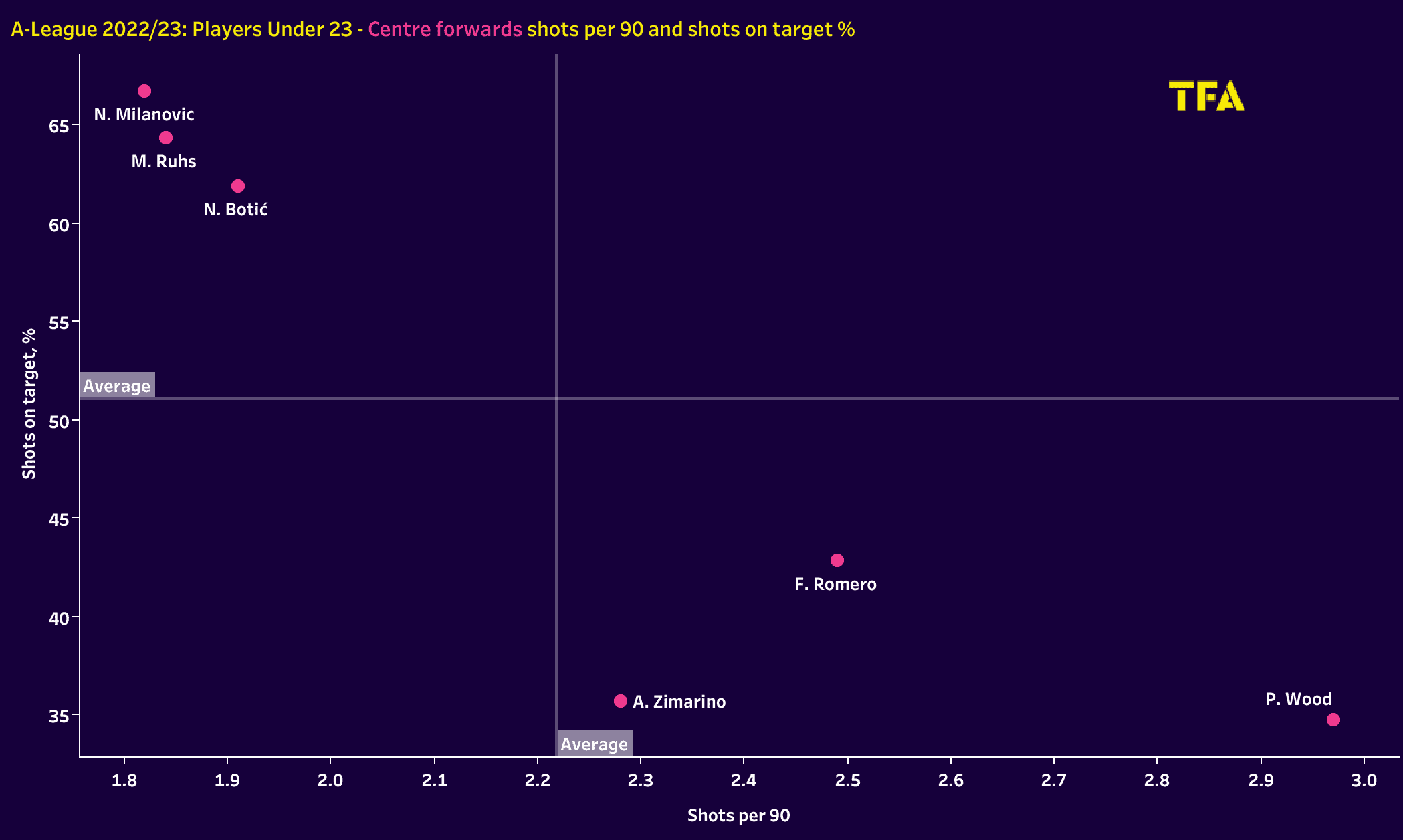
From this data visual, we can see that Botić, Ruhs and Milanovic fare well in terms of their shooting accuracy. None of them averaged more than two shots per 90, but all had a ‘shots on target’ percentage of over 60%; this indicates that they found the target with the majority of their shots.
A higher shots on target percentage demonstrates the player’s ability to make informed decisions in shooting situations. It suggests that they possess good shot selection and can choose the right moments to shoot and select the appropriate target areas. This decision-making skill allows them to avoid wasteful or speculative shots that may be easily saved or miss the target altogether.
On the other hand, if a striker takes more shots but few of them hit the target, as we can see above with Romero, Wood and Zimarino, it could indicate several things. It may suggest a lack of accuracy or composure in shooting situations, leading to shots being off-target or easily saved by the goalkeeper. This inefficiency can result in missed scoring opportunities and a lower goal conversion rate.
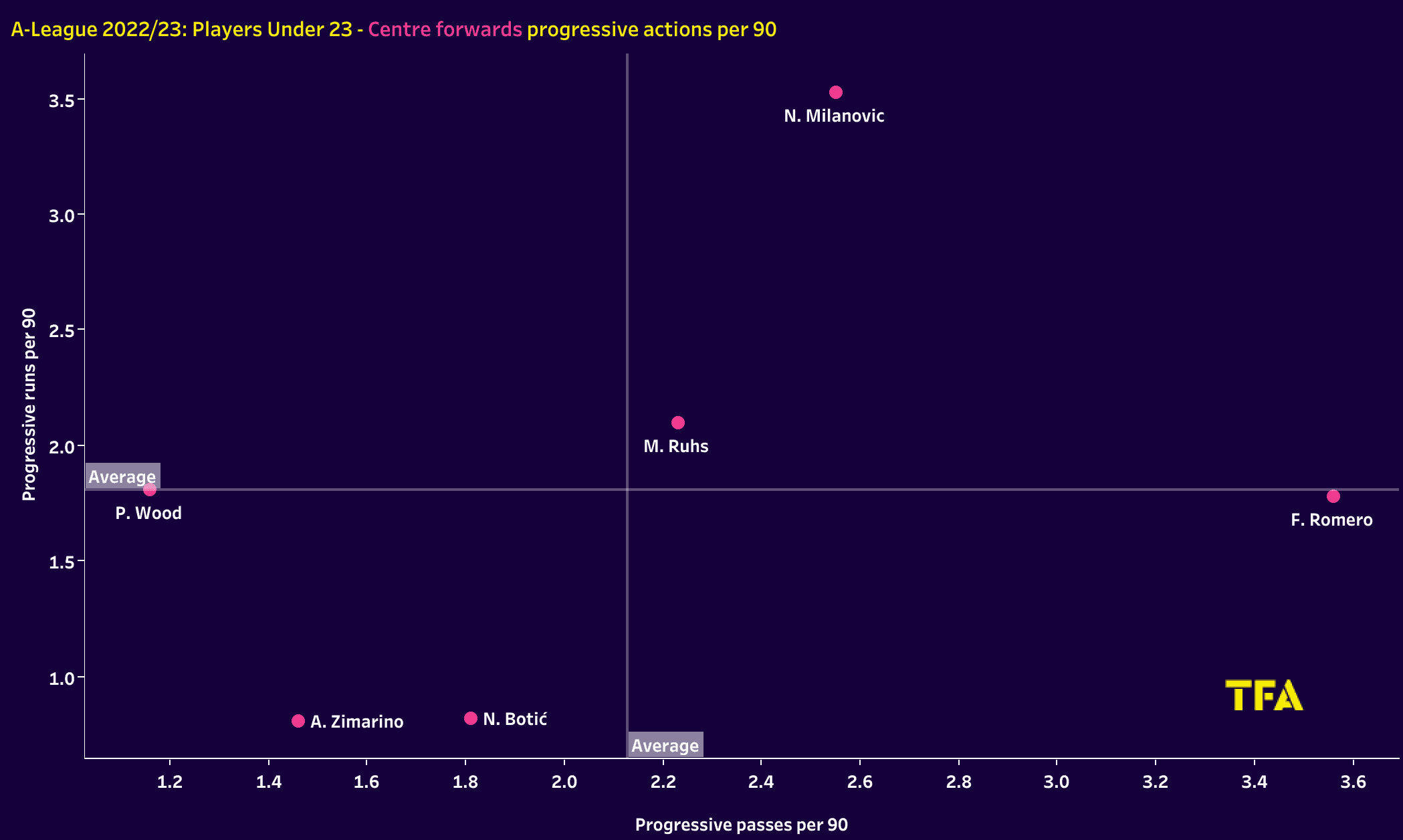
Finally, if we look at the ball progression statistics, we can see that Milanovic averaged 2.55 progressive passes per 90 and 3.53 progressive runs per 90. Meanwhile, Botić appears to have been used as more of a target forward to link the play than a striker who will carry the ball upfield. Michael Ruhs also plays for Western United alongside Botić, which suggests that the two offer different skill sets, which allows the manager to adjust the team’s playing style throughout the game. Additionally, with his ball progression stats, it appears as though Ruhs could be useful in the wide areas, which adds an extra dimension to his game.
This brings to an end the data analysis section. In the next part of this analysis, we will highlight a young player to watch in the A-League.
One to watch
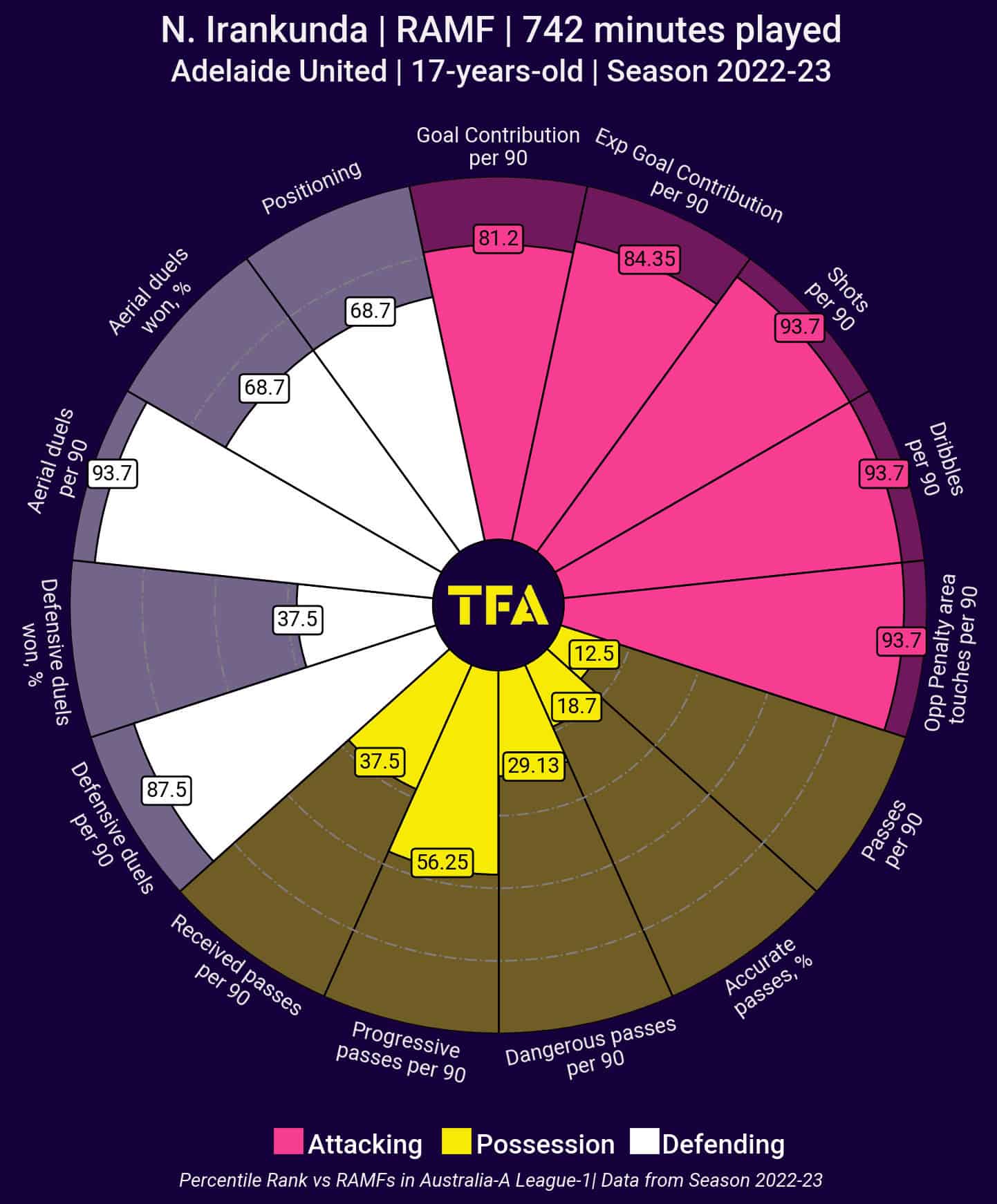
If we were to highlight one player to watch, Nestory Irankunda of Adelaide United stands out. The 17-year-old attacking winger, rumoured to be on Bayern Munich’s radar, showcases versatility by being comfortable on either side and has even been deployed as a centre forward on a few occasions. The pizza chart above indicates Irankunda’s exceptional activity in the attacking third, emphasising his comfort with the ball at his feet, as evident from his high ranking in dribbles per 90 compared to other players in his position. Despite engaging in an increased number of aerial and defensive duels per 90, Irankunda’s success rate in winning these duels is relatively lower. However, he compensates with a significant number of progressive passes per 90, demonstrating his ability to influence the team’s attacking play and provide a creative outlet.
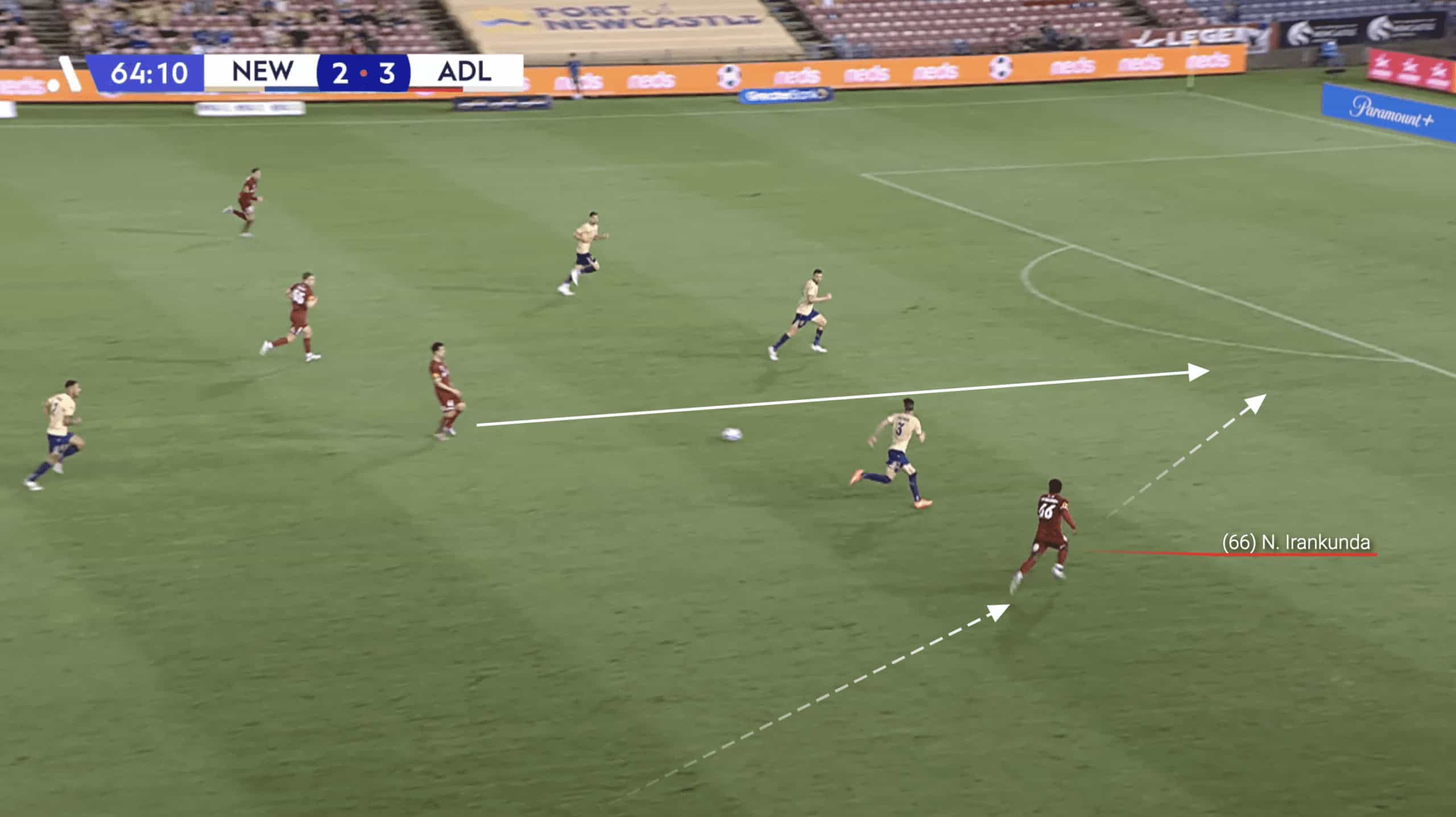
The image above exemplifies how Irankunda utilises his remarkable speed to outpace opposing defenders and initiate inverted runs from the right wing. In this particular situation, he receives the ball and effectively employs his agility and close control to prevent the defender from closing in. With exceptional ball-carrying skills, he confidently takes the ball into the penalty area and executes a shot at goal.
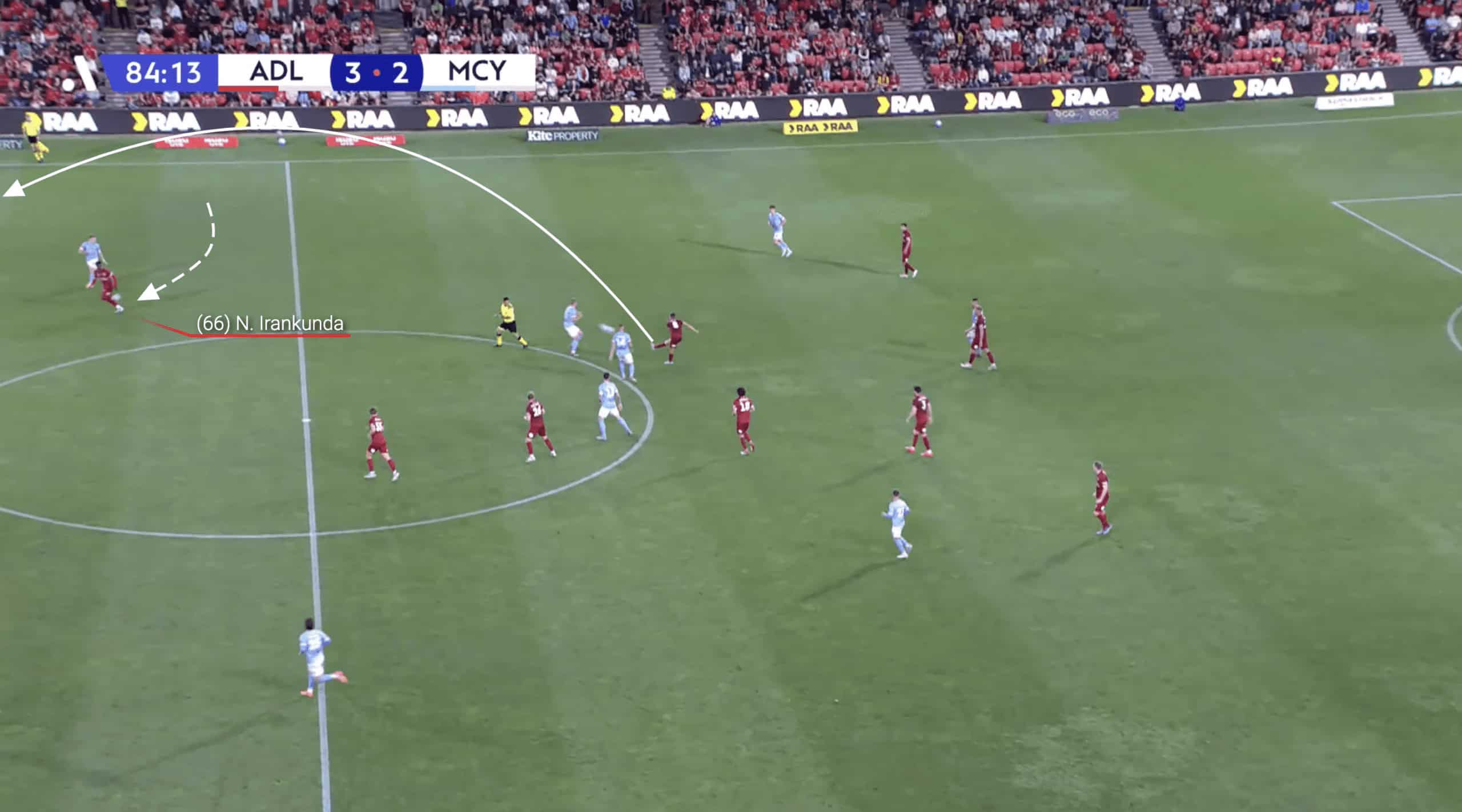
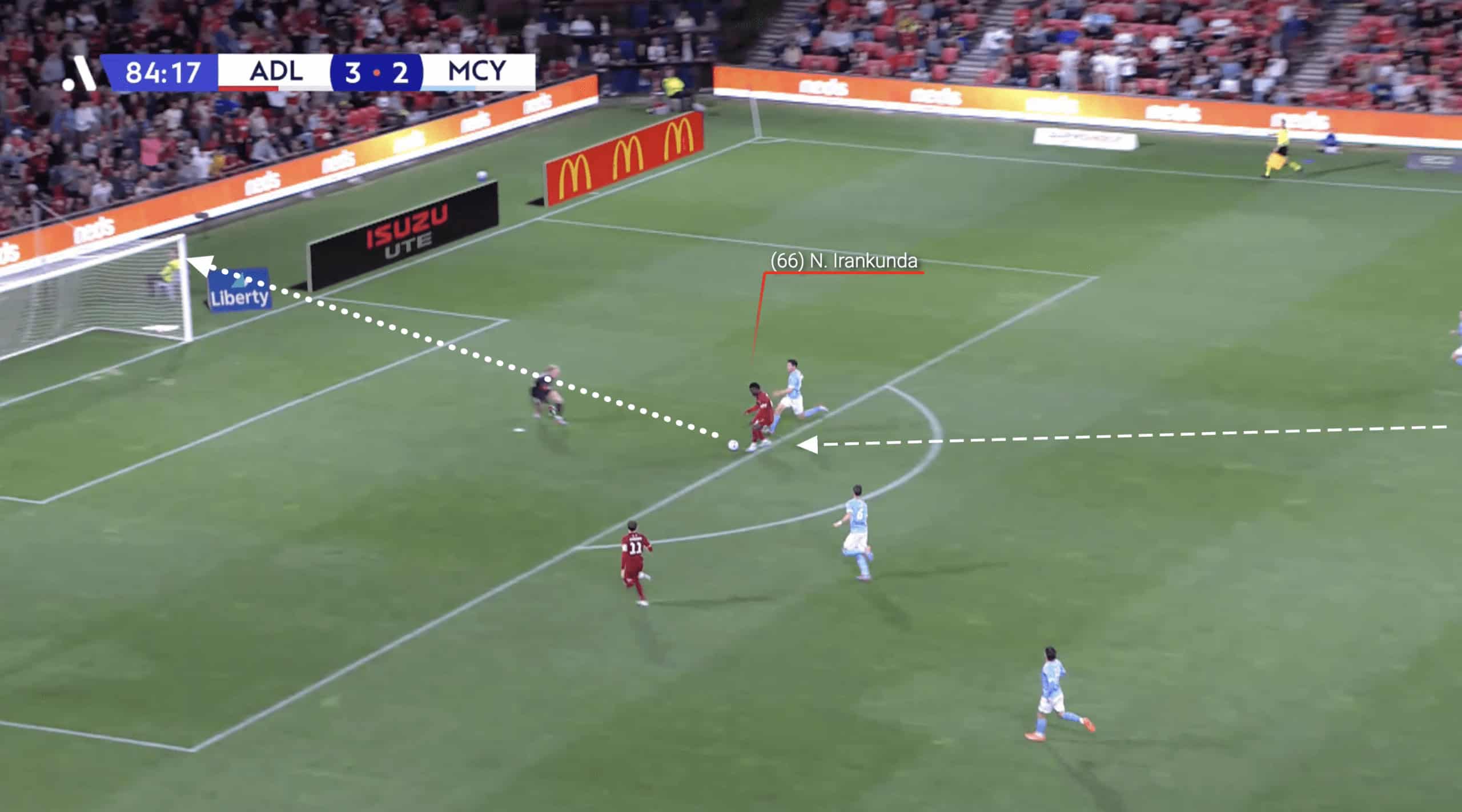
In this example, we see Irankunda utilising his exceptional pace to execute a remarkable off-the-ball run, capitalising on a long pass from a teammate. His speed makes him an ideal outlet for counter-attacks, as demonstrated here. Furthermore, Irankunda showcases his proficiency in shooting with his weaker left foot, lofting the ball over the goalkeeper and into the back of the net. This skill significantly increases his scoring opportunities in various game situations. Irankunda’s ability to effectively use both feet when faced with fast-paced or pressured scenarios allows him to react swiftly and exploit shooting chances from different angles. It eliminates unnecessary adjustments or additional touches, empowering him to strike the ball rapidly while maintaining a higher level of accuracy.
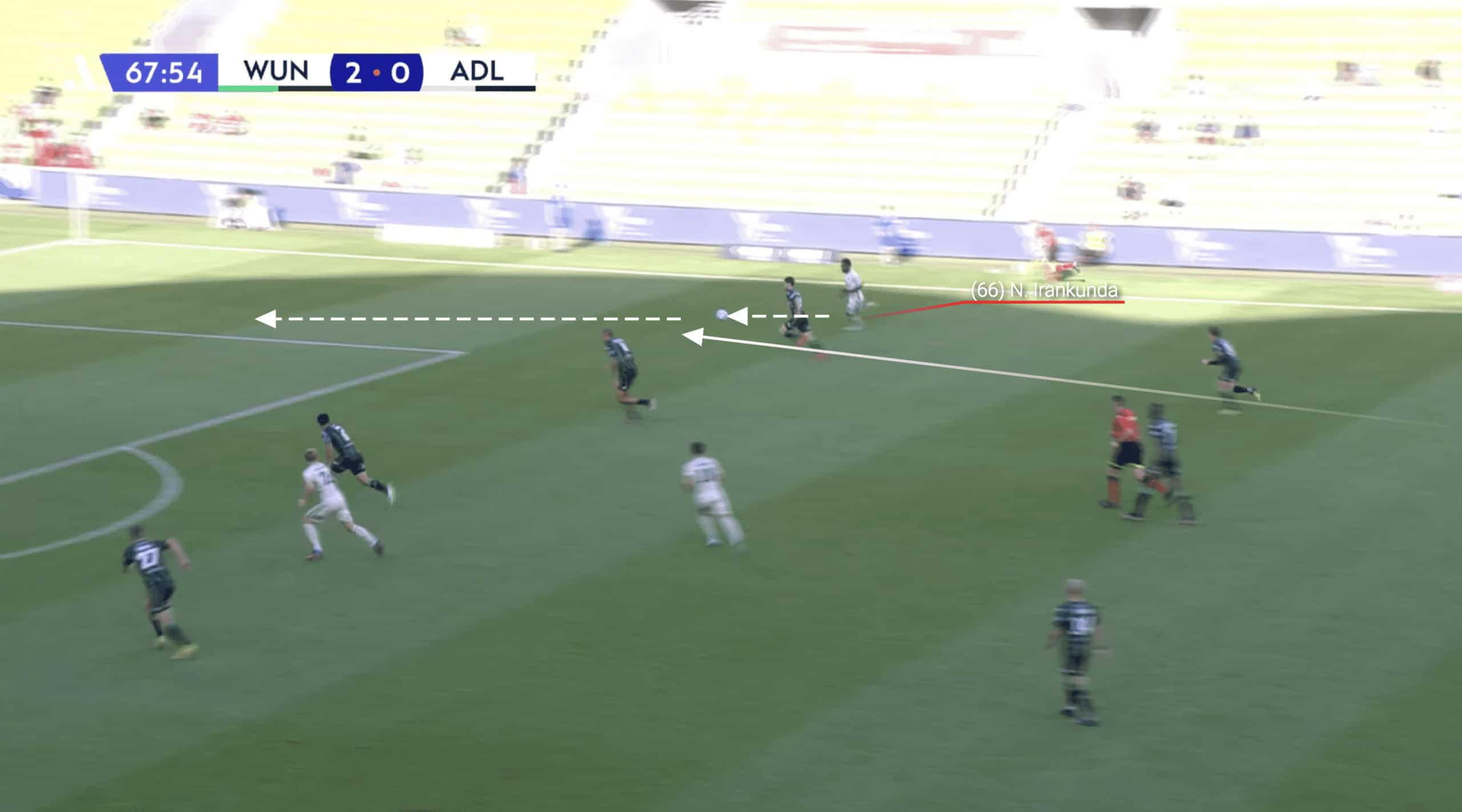
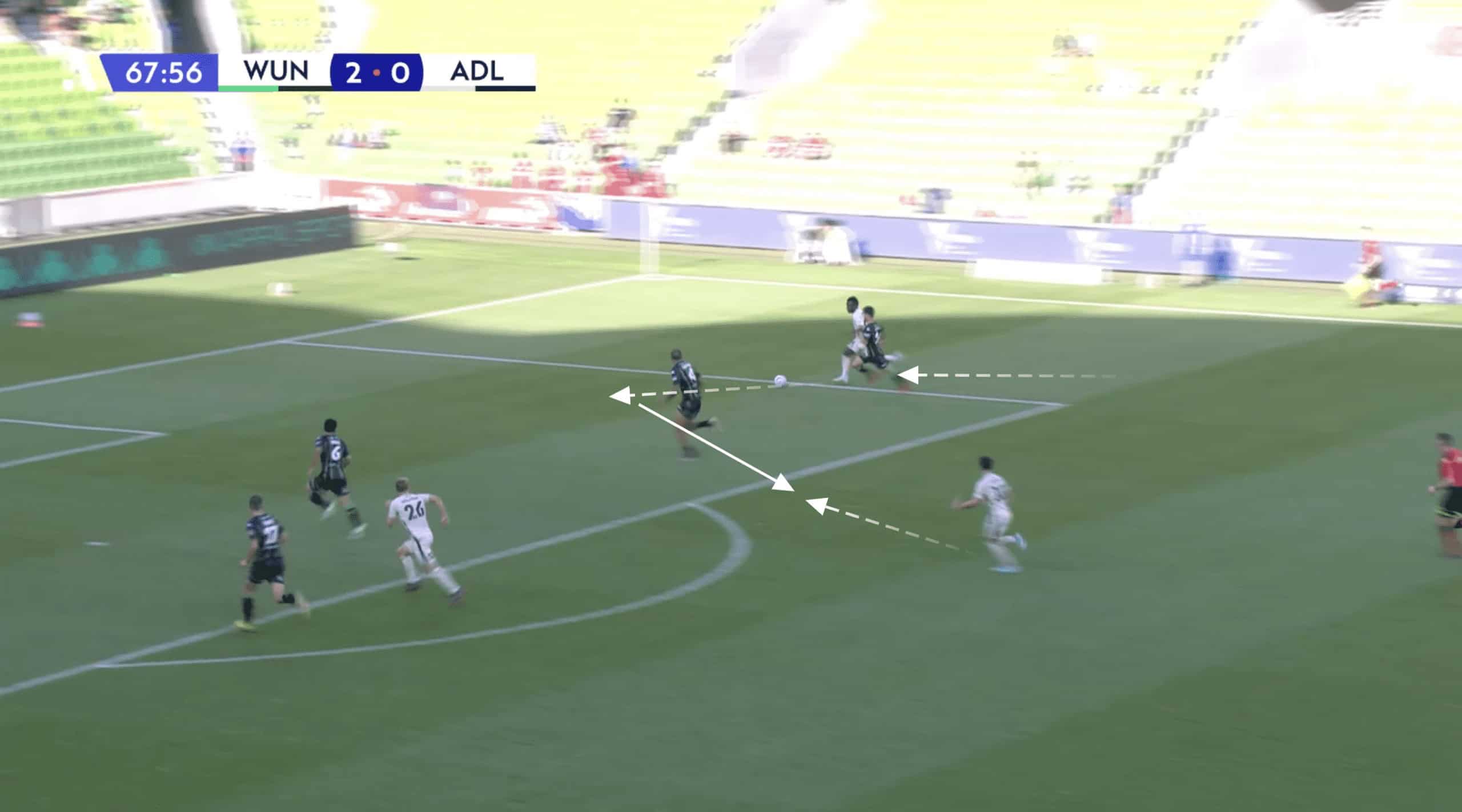
Furthermore, his excellent ball-carrying skills are on show here as he can comfortably breeze past his opponent, using his strength to shield the ball and his agility to change direction quickly, allowing him to create enough space to pass the ball back to his teammate. As soon as he receives the ball, his initial reaction is to carry it as far as possible. Throughout the season, Irankunda averaged 11.40 dribbles per 90, which shows how adept he is with the ball at his feet.
By utilising his dribbling skills, the youngster can open up space, and create gaps in the defence, thus destabilising the opposition’s structure. As shown above, this ability to beat defenders in one-on-one situations gives him a direct path towards the goal or a chance to deliver a cross into the box.
His technique means he can navigate through tight spaces, evade tackles, and retain possession, ultimately preventing turnovers and maintaining attacking momentum. Additionally, Irankunda’s ball-carrying abilities often attract the attention of multiple defenders. This happened in the scenario shown above, as two defenders were preoccupied with Irankunda, which created space for his teammate to exploit.
At only 17 years old, Irankunda has a very bright future ahead of him. With European clubs already watching him, he could be the subject of plenty of transfer speculation in the near future.
Conclusion
This brings our data analysis to an end. We have analysed players under 23 who played more than 500 minutes in the A-League last season. We have understood why players such as Jordan Bos, Marco Tilio and Keegan Jelacic have been snapped up by European clubs and seen how some of the other players under the age of 23 have fared throughout the season. We have highlighted why Nestory Irankunda is a player to watch and showcased some of his exciting skills, which has seen him pop up on Bayern Munich’s radar.
The A-League as a whole has benefited from giving game time to young players; with a record transfer fee coming in for Tilio, it could be a sign that many more European clubs will start to look towards Australia for talented young players.





Comments